Selected
Takao 599 museum has all kinds of animals inhabit in Mt. Takao in various ways of exhibitions such as seasonal wild plants preserved in acrylic and all kinds of animals specimens inhibits in Mt. Takao. On the "NATURE WALL," stuffed animals are displayed and shows the movie to introduce the dynamic nature of Mt. Takao.
-
Lucanus maculifemoratus Lucanidae
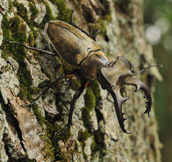
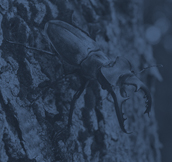 Lucanus maculifemoratus Lucanidae
Lucanus maculifemoratus Lucanidae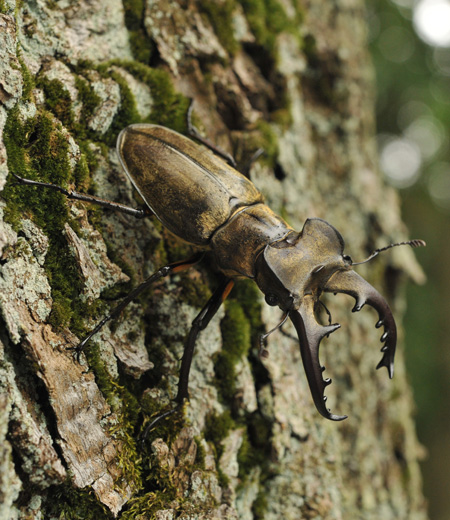 Main region: Hokkaido, Honshu, Shikoku, Kyushu, Sado Island and Iki Island.
Main region: Hokkaido, Honshu, Shikoku, Kyushu, Sado Island and Iki Island.
Found in woodland and beechwood forests.
Are popular for their masculine body but limited habitat compare to dorcus rectus and prosopocoilus inclinatus. The protrusions are from the back of their head that is unique to this species.
They grow with age like mandibles and rarely seen on small species.
Male body is brownish black to brownish red with gold hair on body surface.
Female body is brownish black.
They are more active at night than daytime, fly to quercus acutissimam and quercus serrata for sap.
●Length about 30 to 80 mm
●Adult Flight Season July to about August -
Trypoxylus dichotomus (Japanese Rhinoceros Beetle) Scarabaeidae
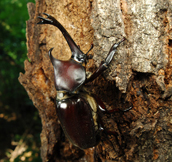
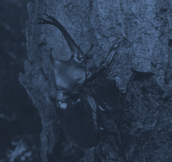 Trypoxylus dichotomus (Japanese Rhinoceros Beetle) Scarabaeidae
Trypoxylus dichotomus (Japanese Rhinoceros Beetle) Scarabaeidae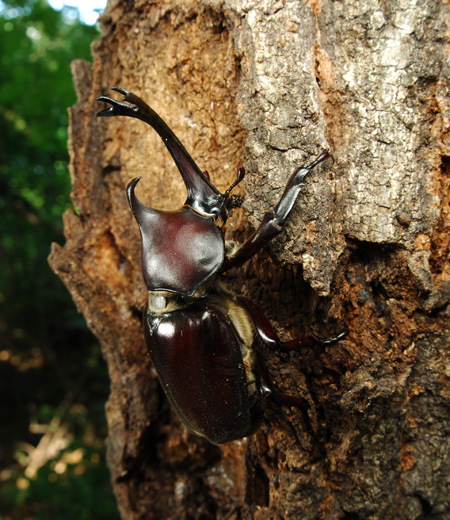 Main region: Honshu, Shikoku and Kyushu.
Main region: Honshu, Shikoku and Kyushu.
Male have big and brave horn and are called as the king of insects in Japan and has been very popular among children but they are also found in the Korean Penninsula, China and north of Indochina Peninsula.
Found in forests and woodlands from flatland to mountains and fly to fly to quercus acutissimam and quercus serrata for sap.
Have sharp claws at the tips of legs that enable them to hold their bodies to vertically grown tree.
With their horn and big bodies, do not allow other insects gather for sap of tree.
Lay eggs in soil and emerge to adults on the following year and live only for two to three months.
● Length (including horn) about 30 to 50 mm
● Season June to about August -
日铜罗花金龟 Scarabaeidae
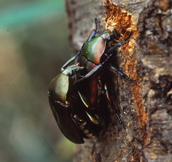
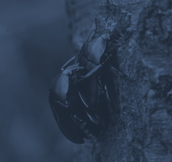 日铜罗花金龟 Scarabaeidae
日铜罗花金龟 Scarabaeidae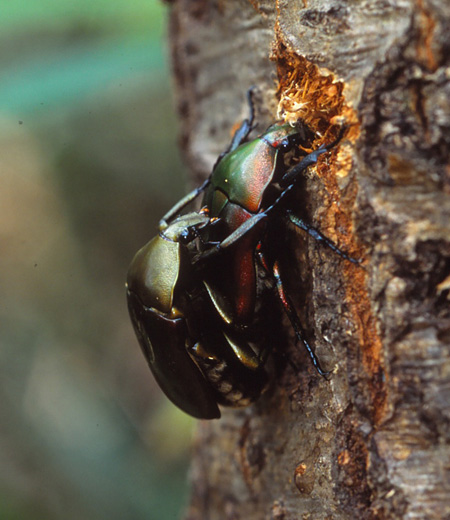 分布于本州、四国、九州和佐渡岛、伊豆诸岛、五岛列岛、屋久岛等地。主要栖息在低地的杂木林和森林等处。也常见于高尾山的山路和林间小道上。也常出现于市中心的公园和林荫树上。身体扁平,头四方形,特征明显。体色有个体差异,从铜色到近绿色不定,但全都具有独特的光泽,非常漂亮。白天,聚集在麻栎、枹栎、柳树等树上食树液,飞行能力强,可以不打开前翅,只展开后翅飞行。
分布于本州、四国、九州和佐渡岛、伊豆诸岛、五岛列岛、屋久岛等地。主要栖息在低地的杂木林和森林等处。也常见于高尾山的山路和林间小道上。也常出现于市中心的公园和林荫树上。身体扁平,头四方形,特征明显。体色有个体差异,从铜色到近绿色不定,但全都具有独特的光泽,非常漂亮。白天,聚集在麻栎、枹栎、柳树等树上食树液,飞行能力强,可以不打开前翅,只展开后翅飞行。
●体长/22~30mm
●成虫活动期/7~8月 -
Rhomborrhina unicolor Scarabaeidae
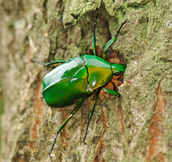
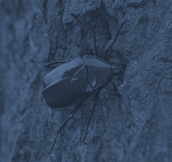 Rhomborrhina unicolor Scarabaeidae
Rhomborrhina unicolor Scarabaeidae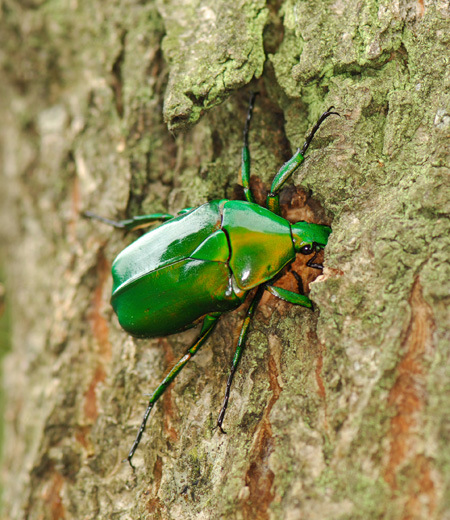 Main region: Honshu, Shikoku, Kyushu, Sado Island, Tanega Island and Yaku Island.
Main region: Honshu, Shikoku, Kyushu, Sado Island, Tanega Island and Yaku Island.
Found in woodland or forests from low elevation to mountains.
Suck sap of quercus acutissimam, quercus serrata and basket willow.
During short summer from July to August, seen on these trees with stag beetles, beetles and bees for sap.
Body size and biology is quite similar to rhomborrhina japonica.
Body color of rhomborrhina japonica varies from copper to green but that of this species is deep metallic green.
There is also a species called rhomborrhina polita which body color is black.
This species and rhomborrhina polita are rarely found in city area.
Length about 22 to 30 mm
Adult Flight Season July to about August -
Paratrichius doenitzi Scarabaeidae
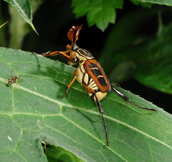
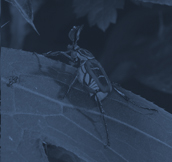 Paratrichius doenitzi Scarabaeidae
Paratrichius doenitzi Scarabaeidae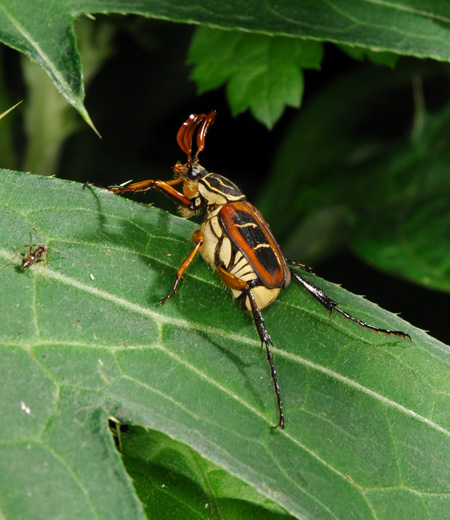 Main region: Honshu.
Main region: Honshu.
Found in green area or grassland from low elevation to mountains.
Is a kind of cetonia that can only be seen from early summer to summer.
Is popular among fans of insects for the large colorful patterns on its back.
This pattern is seen only on male and female has white pattern on their black body and a lot different from males.
Their antennas are spread in three.
Seen on leaves or flowers on grass on mountain trails.
Fly various places and flowers and eat pollen.
Larva eats rotten wood.
●Length about 12 to 16 mm
●Adult Flight Season June to about August -
Popillia japonica Scarabaeidae
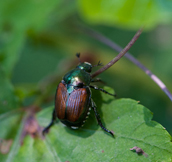
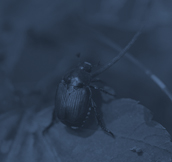 Popillia japonica Scarabaeidae
Popillia japonica Scarabaeidae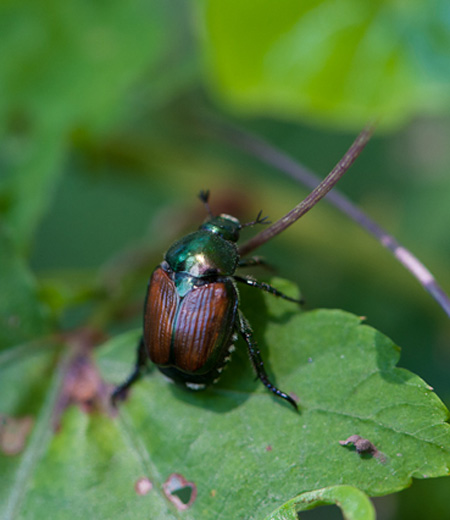 Main region: Hokkaido, Honshu, Shikoku, Kyushu, Tsushima and Yaku Island.
Main region: Hokkaido, Honshu, Shikoku, Kyushu, Tsushima and Yaku Island.
Found in green space or grassland from flatland to mountains.
Larva eats various kinds of plants in soils and sometimes roots of fabaceae family.
Adults are known as destructive insects because eat sprout, leaves and flowers of the plants, so they are often found in farmland rather than in natural environment.
Sometimes they grow in large numbers to cause damage to cultivations.
Body length is small and about 1cm.
Body color from head to abdomen is shiny deep green and its front wing surface has shiny red brown color and is quite beautiful.
Appear from the early summer and tends to gather to food plants during the daytime.
●Length about 9 to 13 mm
●Adult Flight Season May to about August -
Phelotrupes laevistriatus Scarabaeidae
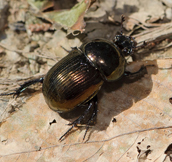
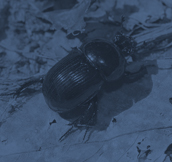 Phelotrupes laevistriatus Scarabaeidae
Phelotrupes laevistriatus Scarabaeidae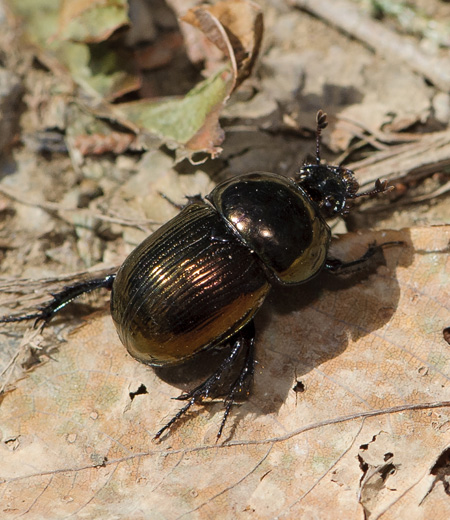 Main region: Hokkaido, Honshu, Shikoku, Kyushu, Tsushima and Yaku Island.
Main region: Hokkaido, Honshu, Shikoku, Kyushu, Tsushima and Yaku Island.
Found in green area or forests from flatland to mountains as well as cropland and residential area.
Body color is mostly metallic black and sometimes purplish, indigo or greenish black and they are quite beautiful.
They are so-called dung beetles and their main foods are dungs from animals and seek them while flying close to the ground with beating its wings or walking on grounds.
Female bring dungs in soils and lay eggs in soils sealed with dungs and larva can eat them to grow.
In Takao, easily be found on mountain trails.
●Length about 14 to 20 mm
●Adult Flight Season April to about November -
Coccinella septempunctata (Seven-spot Ladybird) Coccinellidae
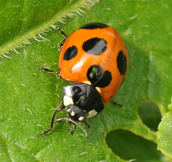
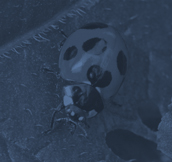 Coccinella septempunctata (Seven-spot Ladybird) Coccinellidae
Coccinella septempunctata (Seven-spot Ladybird) Coccinellidae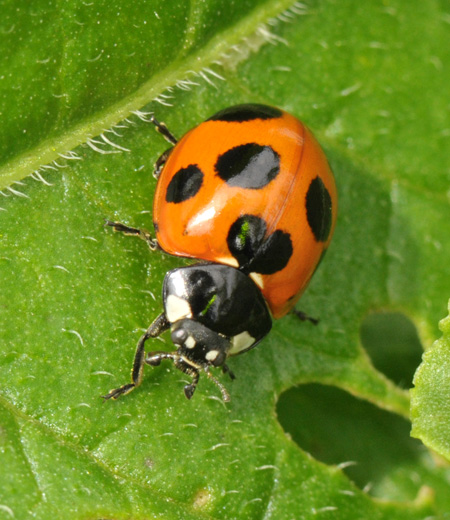 Main Region: Hokkaido, Honshu, Shikoku, Kyushu, Okinawa, Ogawasara Islands and Miyako Island.
Main Region: Hokkaido, Honshu, Shikoku, Kyushu, Okinawa, Ogawasara Islands and Miyako Island.
Found in grasslands and green spaces from flatlands to mountains and also at parks and street trees in cities.
Is the most commonly known insect in Japan.
Have seven black spots on shiny red forewings, hence the Japanese name Nanahoshi-tento seven stars ladybug.
Are seen from spring to early autumn.
Are predatory and feed on plant louse that is widely known.
When noticing dangers, emit smelly and yellow body fluids from joints of legs to protect them.
Larvae also feed on plant louse but body shape is different from adults and is like hairy caterpillars.
●Length about 5 to 8 mm
●Adults Flight Season March to about November -
Aiolocaria hexaspilota Coccinellidae
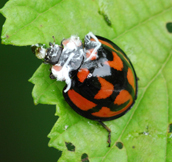
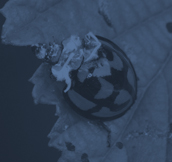 Aiolocaria hexaspilota Coccinellidae
Aiolocaria hexaspilota Coccinellidae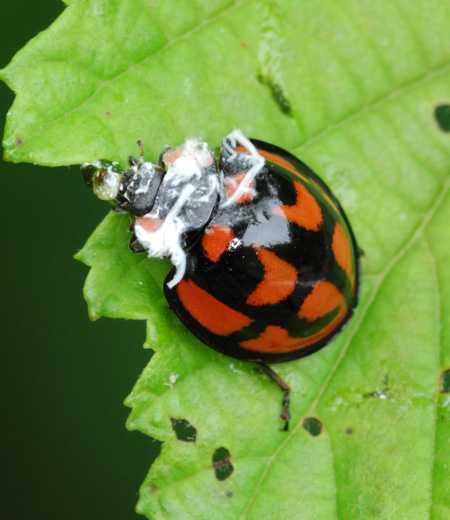 Main Region: Hokkaido, Honshu, Shikoku and Kyushu. Found in woods, green spaces from flatlands to mountains and also along streams in valleys. Is the largest species in Coccinellidae family native to Japan and looks quite strange for ladybugs with the size of larger than 1cm. Fore wings are shiny with red and black complicated patterns like tortoise, hence the Japanese name Kamenoko-tento literally meaning tortoise ladybug. Is seen from early spring to early autumn and adults and larvae feed on larvae of gastrolina depressa and chrysomela populi often found on Japanese walnut and Japanese wingnut and chrysomela vigintipunctata often found on willow. When sensing dangers, exuding smelling body fluids just like most species in ladybugs. In early winter, cluster in gaps of barks or under stones to spend winter.
Main Region: Hokkaido, Honshu, Shikoku and Kyushu. Found in woods, green spaces from flatlands to mountains and also along streams in valleys. Is the largest species in Coccinellidae family native to Japan and looks quite strange for ladybugs with the size of larger than 1cm. Fore wings are shiny with red and black complicated patterns like tortoise, hence the Japanese name Kamenoko-tento literally meaning tortoise ladybug. Is seen from early spring to early autumn and adults and larvae feed on larvae of gastrolina depressa and chrysomela populi often found on Japanese walnut and Japanese wingnut and chrysomela vigintipunctata often found on willow. When sensing dangers, exuding smelling body fluids just like most species in ladybugs. In early winter, cluster in gaps of barks or under stones to spend winter.
●Length about 8 to 12 mm
●Adults Flights Season April to about October -
Acrothinium gaschkevitchii Chrysomelidae
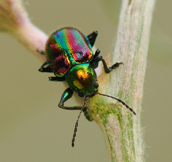
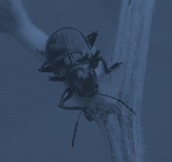 Acrothinium gaschkevitchii Chrysomelidae
Acrothinium gaschkevitchii Chrysomelidae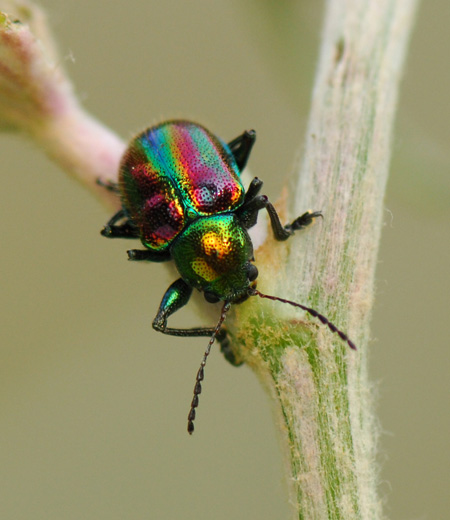 Main Region: Hokkaido, Honshu, Shikoku, Kyushu and Okinawa.
Main Region: Hokkaido, Honshu, Shikoku, Kyushu and Okinawa.
Found in woods and surrounding grasslands from flatlands to mountains and also in croplands.
Body color varies among individuals of the same species.
Most of them have red-copper on upper parts of fore wings and metallic green on the rest as the Japanese name Aka-gane-saru-hamushi literally meaning red copper monkey chrysomelidae states.
Body color looks different by viewing angles and is very beautiful.
Are seen from spring to summer and feed on leaves of plants in vitaceae family including Vitis ficifolia var. lobata, Corylopsis spicata Sieb. et Zucc., and mint and often found on these plants.
Larvae feed on roots of plants that adults feed on.
Both larvae and adults are known as pests for plants in vitaceae family.
●Length about 5 to 7 mm
●Adults Flight Season May to about August -
Leptura ochraceofasciata Cerambycidae
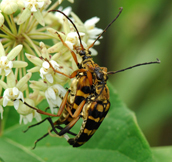
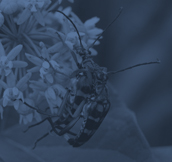 Leptura ochraceofasciata Cerambycidae
Leptura ochraceofasciata Cerambycidae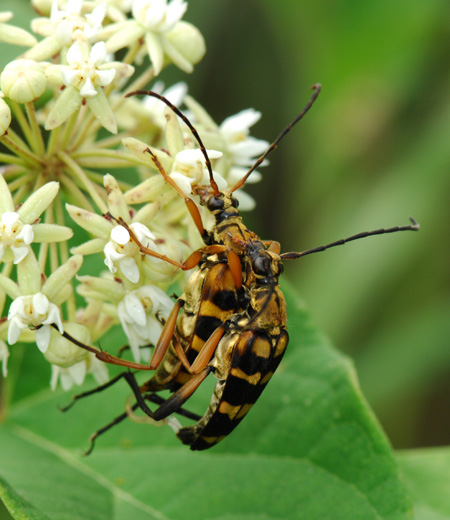 Main region: Hokkaido, Honshu, Shikoku, Kyushu, northern islands of Izu Islands, Rishiri Island, Sado Island, Oki Island and Goto Islands.
Main region: Hokkaido, Honshu, Shikoku, Kyushu, northern islands of Izu Islands, Rishiri Island, Sado Island, Oki Island and Goto Islands.
Found in woods and grassland from flatlands to mountains.
Japanese name Yotsusuji-hana-kamikiri literally meaning four lines flower cerambycidae was named because there is four yellow-brown to white four lines on hard outer wings.
Have yellow-brown legs and skinny body that simulates the appearance of bees.
Are seen from mid-June. Adults are a subfamily of lepturinae that feed on pollen and nectar of flowers, and fly to hydrangeas, hydrangea paniculata, Japanese chestnuts, clethra barbinervis and cornus controversa.
The patterns on the body of some species resemble clytini tribe but this species is easily distinguished by skinny thorax.
Larvae feed on trunk of needle leaf trees including yezo spruce and Japanese red pine.
●Length about 12 to 20 mm.
●Adult Flight Season June to about September -
Aredolpona succedanea Cerambycidae
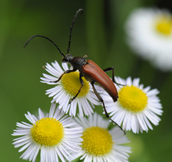
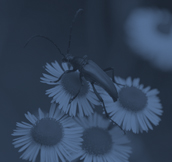 Aredolpona succedanea Cerambycidae
Aredolpona succedanea Cerambycidae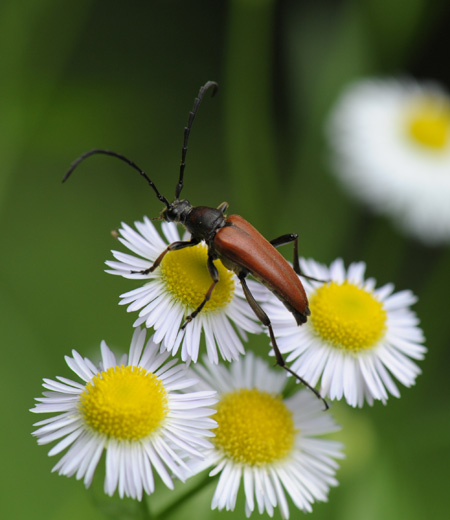 Main region: Hokkaido, Honshu, Shikoku, Kyushu, Okinawa and Rishiri Island.
Main region: Hokkaido, Honshu, Shikoku, Kyushu, Okinawa and Rishiri Island.
Found in forests from flatlands to mountains.
Japanese name Akahana-kamikiri literally meaning red flower cerambycidae was named because most of body parts excluding head are red-brown.
Are often seen in Mt. Takao and it is easy to find with its striking body color.
The thorax of some species is black.
Antennae are shorter than body with saw-toothed tips.
Are seen from midsummer and fly to grasslands and woods and feed on pollen and nectar of flowers including angelica pubescens and hydrangea paniculata.
Larvae feed on deadwoods, fallen trees and logged timbers yezo spruce and abies sachalinensis var. sachalinensis.
●Length about 12 to 22 mm
●Adult Flight Season July to about September -
Rosalia batesi (Blue Longhorn Beetle with Black Spots) Cerambycidae
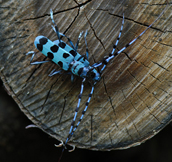
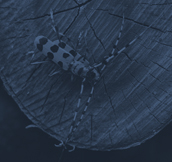 Rosalia batesi (Blue Longhorn Beetle with Black Spots) Cerambycidae
Rosalia batesi (Blue Longhorn Beetle with Black Spots) Cerambycidae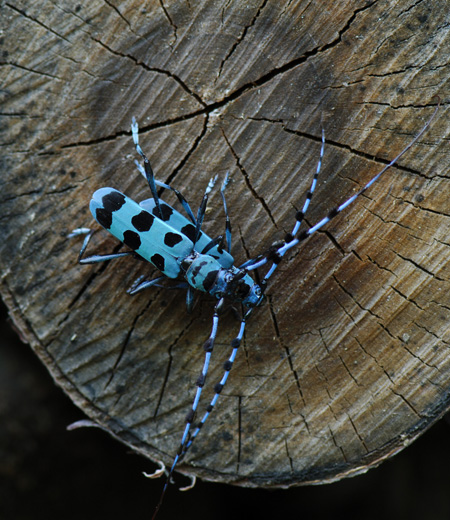 Main region: Hokkaido, Honshu, Shikoku, and Kyushu.
Main region: Hokkaido, Honshu, Shikoku, and Kyushu.
Found in forests and woods from flatlands to mountains.
Japanese name Ruri-boshi-kamikiri literally meaning lazuline star cerambycidae was named because the body color is strong bluish light blue with three paired-black spots.
This species is known as a beautiful cerambycidae.
Some species have these black spots on left side and right part connected.
Antennae are blue and segments with black hairs.
Are seen from June and active during daytime.
In Mt. Takao, are often seen at fallen trees of fagus japonica maxim.
Also fly to quercus serrata for sap and flowers of clethra barbinervis.
Larvae also feed on woods of trees in fagaceae family that adults also feed on.
●Length about 18 to 30 mm
●Adult Flight Season June to about September -
Anoplophora malasiaca (White-spotted Longicorn Beetle) Cerambycidae
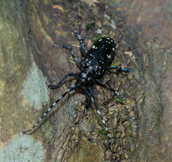
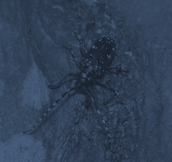 Anoplophora malasiaca (White-spotted Longicorn Beetle) Cerambycidae
Anoplophora malasiaca (White-spotted Longicorn Beetle) Cerambycidae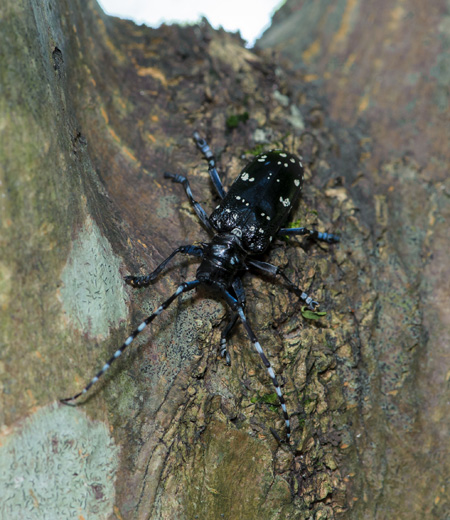 Main region: Hokkaido, Honshu, Shikoku, Kyushu, Okinawa, Sado Island, Oki Island, Tsushima, Tanega Island and Yaku Island.
Main region: Hokkaido, Honshu, Shikoku, Kyushu, Okinawa, Sado Island, Oki Island, Tsushima, Tanega Island and Yaku Island.
Found in woods from flatlands to mountains.
Are most well-known species in cerambycidae family as both adults and larvae feed on various kinds of plants in salicaceae family, castanopsis genus, rutaceae family and aceraceae family that could be found in farmlands.
In Mt. Takao, are often found in mountain trails.
Shiny black body has some white spots.
Antennae are light blue and black stripe patterns and their length are double the size of body length for male and 1.2 times longer for female adults.
Sometimes cause serious damage to trees at gardens and streets.
●Length about 25 to 35 mm
●Adult Flight Season June to about August -
Psacothea hilaris(Yellow-spotted Longicorn Beetle) Cerambycidae
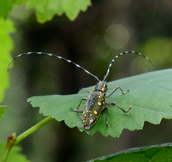
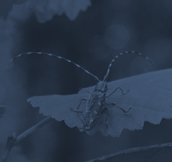 Psacothea hilaris(Yellow-spotted Longicorn Beetle) Cerambycidae
Psacothea hilaris(Yellow-spotted Longicorn Beetle) Cerambycidae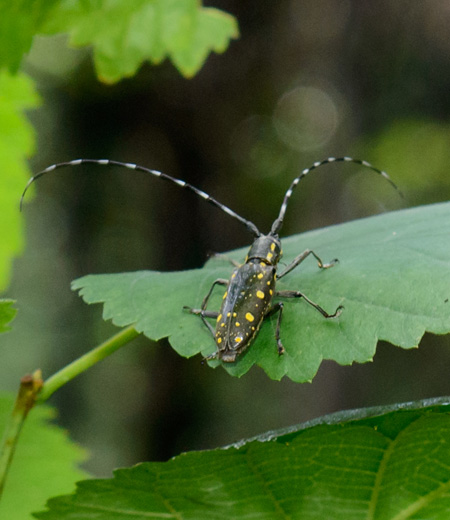 Main region: Honshu, Shikoku, Kyushu, Oki Island, Iki Island and Tsushima.
Main region: Honshu, Shikoku, Kyushu, Oki Island, Iki Island and Tsushima.
Found in forests from flatlands to low elevations but also in farmlands and street trees in cities.
Have long antennae and that of male is three times longer than the body size.
Body color is black with white-yellow to yellow spots.
Are seen from early summer to early autumn and feed on leaves and barks of fig tree, mulberry and plants in rutaceae family with its strong mandibles.
Are also attracted to lights.
Female adults make cracks to these trees and lay eggs.
Hatched larvae feed within these trees and grow.
●Length about 14 to 30 mm
●Adult Flight Season May to about November -
Paraglenea fortune(Ramie Longicorn Beetle) Cerambycidae
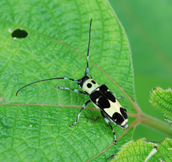
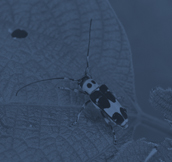 Paraglenea fortune(Ramie Longicorn Beetle) Cerambycidae
Paraglenea fortune(Ramie Longicorn Beetle) Cerambycidae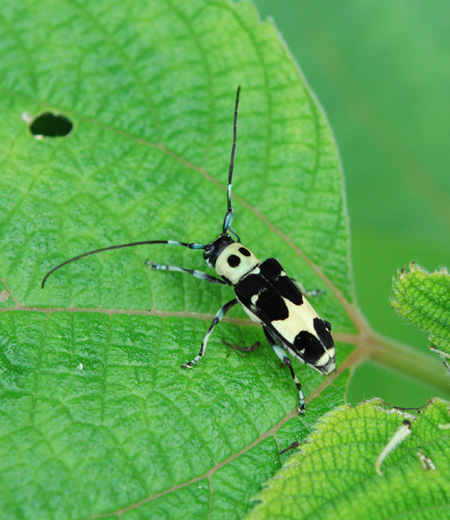 Main region: Honshu (West of Kanto region), Shikoku, Kyushu, Tsushima, Oki Island and Tanega Island.
Main region: Honshu (West of Kanto region), Shikoku, Kyushu, Tsushima, Oki Island and Tanega Island.
Found in woods and surrounding green space from flatlands to mountains.
This is a foreign species came to Nagasaki port with ramie in urticaceae family imported from China during Edo-period.
Main region came up north due to global warming.
Body color is beautiful with white-green and large black spots.
There were not any in Mt. Takao but started to be seen from early 1990s.
Is now one of the species in cerambycidae often seen from May to August.
Are active during daytime and feed on leaves and stems of ramie, boehmeria nivea var. nipononivea, boehmeria japonica, Japanese lime and hibiscus syriacus.
Larvae feed on stems and roots of same plants that adults feed on.
●Length about 10 to 20 mm
●Adult Flight Season May to about August -
Batocera lineolata (White Stripe Long-horned Beetle) Cerambycidae
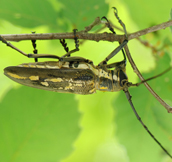
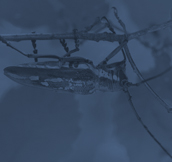 Batocera lineolata (White Stripe Long-horned Beetle) Cerambycidae
Batocera lineolata (White Stripe Long-horned Beetle) Cerambycidae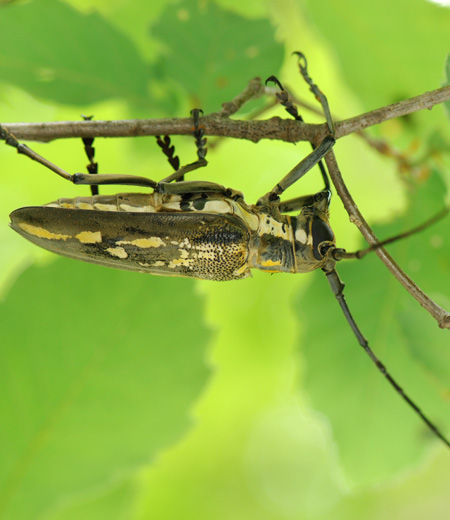 Main Region: Honshu, Shikoku, Kyushu, Sado Island, Oki Island, Tsushima and Amami Island.
Main Region: Honshu, Shikoku, Kyushu, Sado Island, Oki Island, Tsushima and Amami Island.
Found in forests and green space from flatlands to mountains.
Is the largest species in longicorn native to Japan and the large ones become almost 6 cm.
Body color is black covered with gray short hairs.
Have yellow irregular stripes on fore wings but these patterns fade to white when mounted, hence the Japanese name Shirosuji-kamikiri literally meaning white stripes longicorn.
Have large compound eyes and well developed mandibles.
Are active at night but sometime even during daytime.
Adults feed on barks of trees in salicaceae, juglandaceae, betulaceae, fagaceae and ulmaceae grow in wood and also feed on sap of these trees.
Larvae feed on woods of Japanese chestnuts, quercus acutissima and trees in castanopsis family.
●Length about 45 to 55 mm
●Adults Flight Season June to about August -
Paracycnotrachelus longicornis Attelabidae
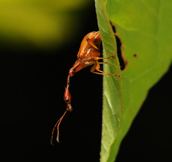
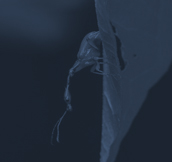 Paracycnotrachelus longicornis Attelabidae
Paracycnotrachelus longicornis Attelabidae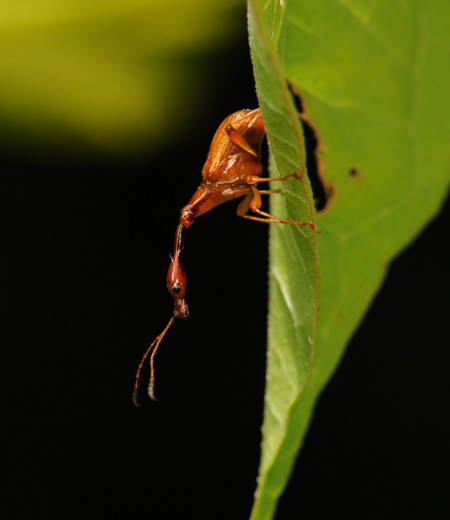 Main Region: Hokkaido, Honshu, Shikoku and Kyushu.
Main Region: Hokkaido, Honshu, Shikoku and Kyushu.
Found in woods and grasslands from flatlands to mountains.
Body color varies among individuals of the same species, some have yellow-brown but most of them have glossy red-brown to dark-brown.
Male and female are different in body shape, male have elongated head and thorax with long antennae, hence the Japanese name Hige-naga-otosibumi literally meaning barbs long attelabidae.
Male is larger than female. Female does not have long thorax and antennae and resemble apoderus rubidus.
Are seen from early summer to midsummer.
Make cradle with leaves of lindera praecox, kobushi magnolia, Japanese knotweed, lindera sericea and lindera erythrocarpa and drop the cradle to the ground.
●Length about 8 to 12 mm
●Adults Flight Season May to about July -
Mesalcidodes trifidus Curculionidae
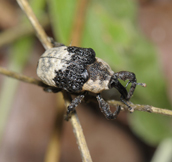
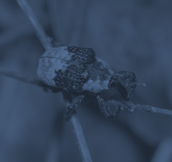 Mesalcidodes trifidus Curculionidae
Mesalcidodes trifidus Curculionidae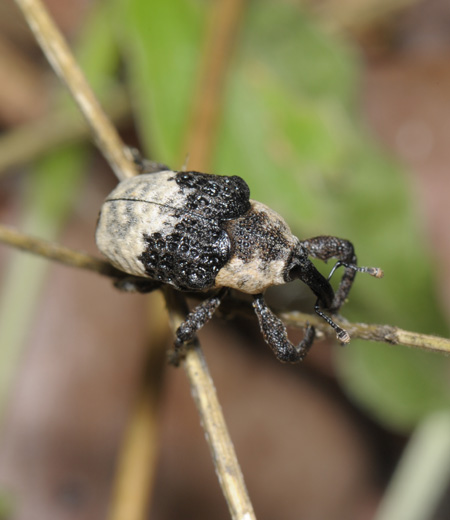 Main Region: Honshu, Shikoku and Kyushu.
Main Region: Honshu, Shikoku and Kyushu.
Found in forests, surrounding green spaces and grasslands from flatlands to mountains.
Body color is black with fine hairs are densely placed called scaly hairs and this part looks white.
The lower parts of fore wings are mostly white, hence the Japanese name Ojiro-ashinaga-zomushi literally meaning tail white long legs curculionidae.
Long legs curculinidae are only to categorize within curculionidae family and the legs of this species are not long.
Are seen from spring and larvae feed on leaves of kudzu and often seen on leaves of the plants.
When noticing danger, fold legs and the entire body become very stiff as if it is dead.
Female lays eggs by making cuts on stems of kudzu and emerged larvae feed on center portion of the stems and grow.
●Length about 9 to 10 mm
●Adults Flight Season April to about October -
Sipalinus gigas Rhynchophoridae
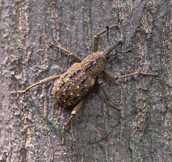
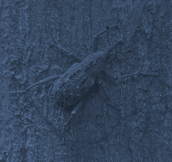 Sipalinus gigas Rhynchophoridae
Sipalinus gigas Rhynchophoridae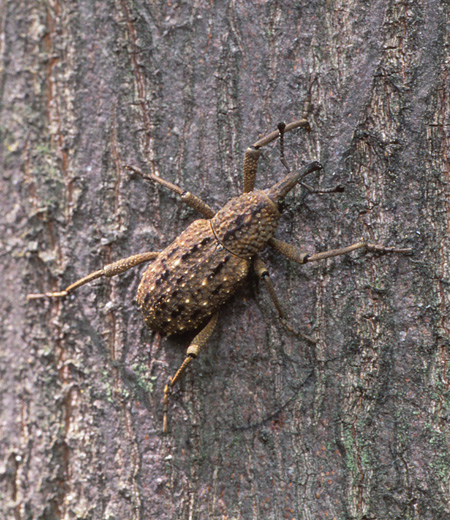 Main Region: Hokkaido, Honshu, Shikoku, Kyushu, Okinawa, Izu Islands and Tsushima.
Main Region: Hokkaido, Honshu, Shikoku, Kyushu, Okinawa, Izu Islands and Tsushima.
Found in woods and forests from lowlands to mountains.
Body color is brown with some black spots but originally the base color was black and black body color appears when they live longer.
Body surface is cast metal-like and very stiff.
Japanese name Oo-zomushi literally meaning large curculionidae was named because this species have elongated distinct mouthparts like an elephant (curculionidae in Japanese literally meaning elephant insects).
Are the largest species in curculionidae family in Japan.
Adults are seen from early summer to midsummer.
Feed on sap of quercus acutissima and quercus serrata.
During daytime, rest under fallen trees and deadwoods.
Adults live for about two years after adult emergence.
Female lays eggs inside of woods and larvae feed on woods and goes deep inside of woods.
●Length about 12 to 29 mm
●Adults Flight Season June to about September -
Vespa mandarinia japonica(Japanese Giant Hornet) Vespidae
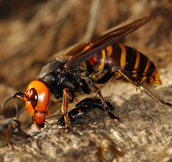
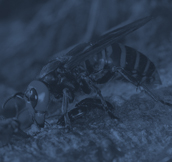 Vespa mandarinia japonica(Japanese Giant Hornet) Vespidae
Vespa mandarinia japonica(Japanese Giant Hornet) Vespidae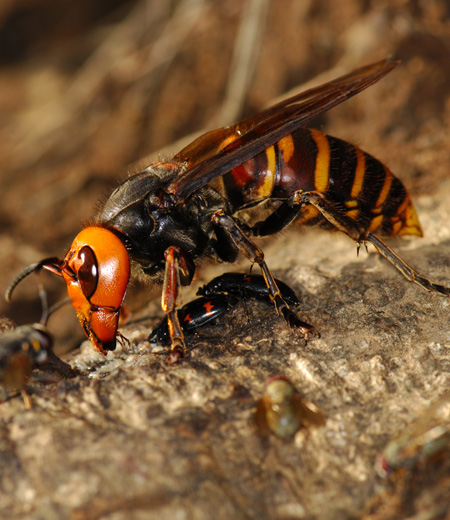 They live widely in Hokkaido, main land Honsyu, Shikoku, Kyusyu as well as Yakushima Island and Tanegashima Island.
They live widely in Hokkaido, main land Honsyu, Shikoku, Kyusyu as well as Yakushima Island and Tanegashima Island.
Thought they inhabit in plain ground and low-mountain areas, they also go out to residential districts.
As largest species of Japanese bees, the striped patterns of thick orange color and black color on their body accentuate them very much.
Their dwelling is the den made under the ground, where they usually inhabit.
Carnivorous as they are, their main bait is mainly big insects; meanwhile they attack the other bees’ dwelling in the group so that they can get other’s pupae and larva for their own feed.
Sap from copse trees is also where they like to gather.
They are very notorious for its aggressiveness and have deadly poison which can stab human to death.
The point is that when you see them or hear the sound of flapping wings ‘Buz’, don’t be upset or panicked to leave there at ease.
Another point to remember is that they gather at sweet drinks or Bento.
●Length about 27 to 45 mm
●Adult Flight Season April to about October -
Vespa simillima xanthoptera Vespidae
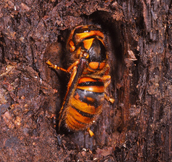
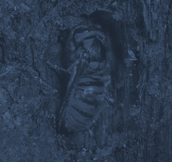 Vespa simillima xanthoptera Vespidae
Vespa simillima xanthoptera Vespidae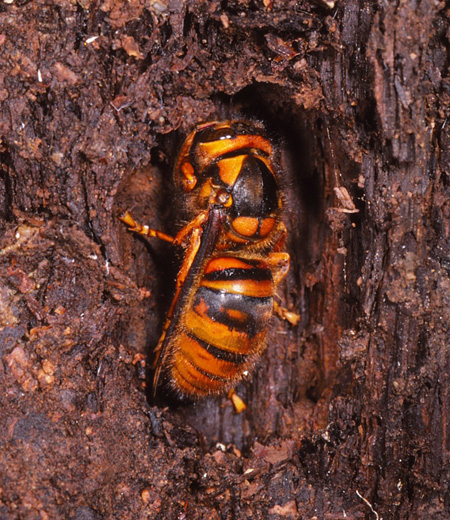 They live widely in main land Honsyu, Shikoku, Kyusyu as well as Sado Island, Tsushia Island and Yakushima Island.
They live widely in main land Honsyu, Shikoku, Kyusyu as well as Sado Island, Tsushia Island and Yakushima Island.
They live near populated area with trees growing thickly or copses in low lands to undeveloped woodlands.
They are medium size hornet smaller by one size than Japanese giant hornet.
Worker bees are about 20 mm, male about 20 to 24 mm , Queen Bee about 25 to 28 mm.
Early spring is the season they begin to appear and start to make their spherical shape beehive in the hollow on the trees or underground.
Recent years, the problem is they make their beehives such as overhangs of a Japanese roof of residential house, walls of residence in urban areas.
As its name shows their body color is conspicuous yellow.
As their characteristic is so offensive that even small stimulus urges them to attack humans.
Therefore, it’s recommended not to come near even when you happen to see beehives.
They love nectar or sap, and catch to eat various insects such as cicada at times.
●Length about 20 to 28 mm
●Adult Flight Season April to about November -
Xylocopa appendiculata Apidae
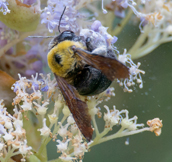
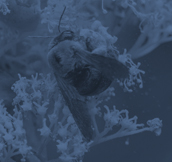 Xylocopa appendiculata Apidae
Xylocopa appendiculata Apidae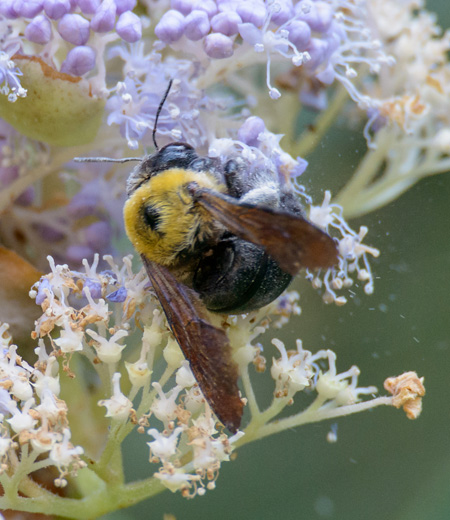 They live widely in main land Honsyu, Shikoku, Kyusyu as well as Tsushima Island and Yakushima Island.
They live widely in main land Honsyu, Shikoku, Kyusyu as well as Tsushima Island and Yakushima Island.
Thought they inhabit at copse at the mountain areas, and around the green tract areas in plan ground, consequently, we can see them in the garden or park in residential districts.
Early spring to early summer, they boom out to appear for various flowers to collect pollen and nectar for their own bait.
Male Apidae has their own territory at the mountain ridge or plain field and we can sometimes see them watching to protect their own territory while they’re hovering.
They dig out shrub or withered branch for breeding place to raise their children in there.
As their sounds of wings are loud and they are densely covered with thick hair, we tend to be afraid of them, but the fact is they’re docile and hardly attack human.
●Length about 20 to 24 mm
●Adult Flight Season March to about October -
Camponotus japonicas Formicidae
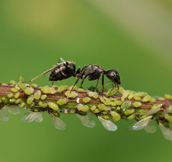
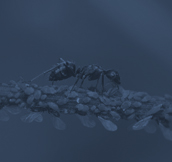 Camponotus japonicas Formicidae
Camponotus japonicas Formicidae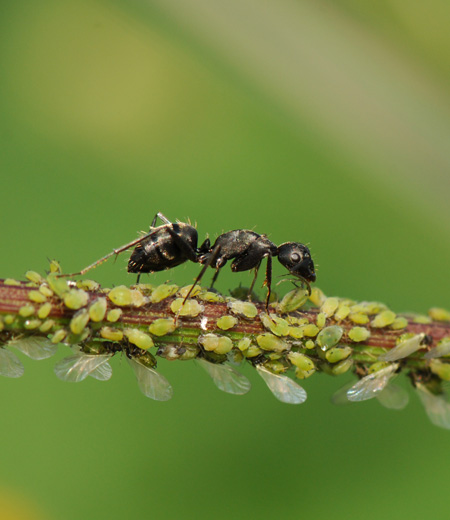 Main Region: Hokkaido, Honshu, Shikoku, Kyushu, Tsushima and Yaku Island. Found in grasslands from flatlands to mountains. Create nest in open ground, thus often found at parks and gardens even in cities. Is the largest species in formicidae native to Japan, worker ants are about 10 mm and queen ant is 17 mm. Body color is black with brownish abdomen. Live in a large colony with a queen ant in underground lair. Catching foods are the job for worker ants. Work in solo or with some and feed on dead insects and body fluids of plant louse. From May to June, male ant with wings and queen ant come out from lair for marriage flight. When they are back on ground, female ant drop wings and create another lair. Take care of some of emerged ants in early stages but once they become worker ants, she becomes queen ant continuously lay eggs.
Main Region: Hokkaido, Honshu, Shikoku, Kyushu, Tsushima and Yaku Island. Found in grasslands from flatlands to mountains. Create nest in open ground, thus often found at parks and gardens even in cities. Is the largest species in formicidae native to Japan, worker ants are about 10 mm and queen ant is 17 mm. Body color is black with brownish abdomen. Live in a large colony with a queen ant in underground lair. Catching foods are the job for worker ants. Work in solo or with some and feed on dead insects and body fluids of plant louse. From May to June, male ant with wings and queen ant come out from lair for marriage flight. When they are back on ground, female ant drop wings and create another lair. Take care of some of emerged ants in early stages but once they become worker ants, she becomes queen ant continuously lay eggs.
●Length about 7 to 13 mm (Worker ants)
●Adults Flights Season April to about November -
Camponotus obscuripes Formicidae
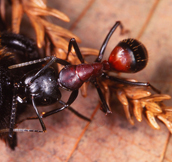
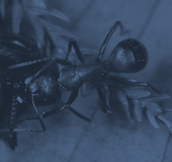 Camponotus obscuripes Formicidae
Camponotus obscuripes Formicidae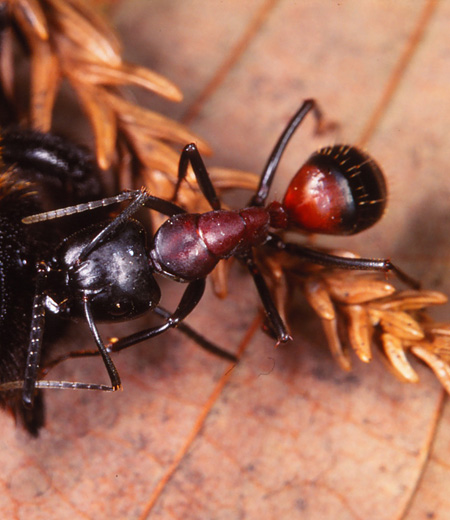 Main Region: Hokkaido, Honshu, Shikoku, Kyushu, Yaku Island and Tsushima.
Main Region: Hokkaido, Honshu, Shikoku, Kyushu, Yaku Island and Tsushima.
Found in forests and grasslands from flatlands to mountains.
Are the largest species like camponotus japonicus habit in Japan and its queen ant is nearly 2 cm.
Color of head and legs are black and that of thorax and the front part of abdomen are red-brown.
Some species have red-brown color only on thorax.
Hardly ever seen in cities as they normally built a next in dead woods or root of tree in forests not in soils. Worker ants are often seen on grounds, generally work in solo and do not form a line.
Feed on dead insects and aphid honeydew.
●Length about 7 to 12 mm
●Adults Flight Season May to about October -
Orthetrum albistylum speciosum (Common Skimmer) Libellulidae
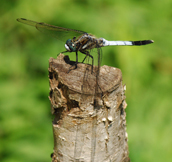
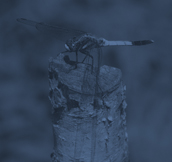 Orthetrum albistylum speciosum (Common Skimmer) Libellulidae
Orthetrum albistylum speciosum (Common Skimmer) Libellulidae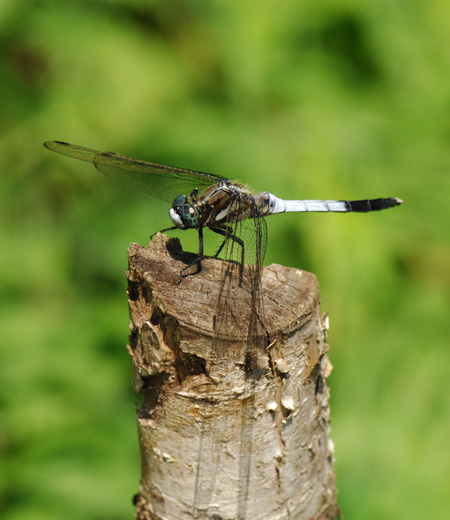 Main region: Hokkaido, Honshu, Shikoku, Kyushu and Okinawa.
Main region: Hokkaido, Honshu, Shikoku, Kyushu and Okinawa.
Found in sunny grassland at waterside of ponds from flatland to low elevations.
Also fly to puddles and one of the dragonflies frequently found in town.
Right after adult emergence in spring, both male and female body colors are brownish yellow with black dots on abdomen.
Only male bodies gradually turn to black with age and from thorax to middle of abdomen are covered by powdery white like salt.
This is the origin of Japanese name Shiokara-Tombo literally meaning salted fish guts dragonfly.
Female body color does not change and also called as Mugiwara-Tombo literally meaning straw dragonfly.
Female hovers over water to dip down the tip of abdomen to lay eggs.
●Length about49 to 55 mm
●Adult Flight Season May to about September -
Sympetrum pedemontanum elatum Libellulidae
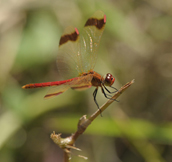
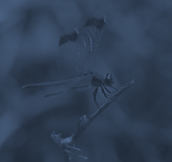 Sympetrum pedemontanum elatum Libellulidae
Sympetrum pedemontanum elatum Libellulidae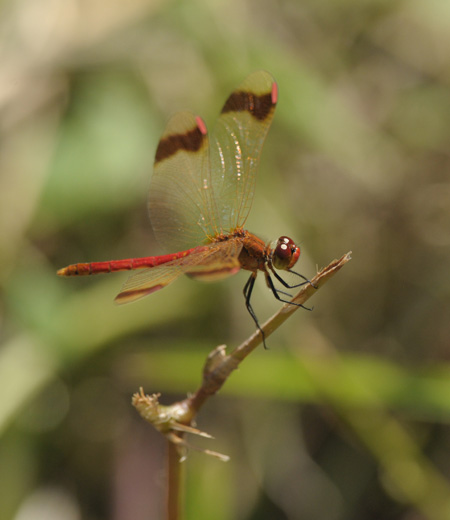 Main region: Hokkaido, Honshu, Shikoku and Kyushu.
Main region: Hokkaido, Honshu, Shikoku and Kyushu.
Found at watersides along slow-flowing streams, paddy fields and ponds from flatland to mountains.
Body turns red like sympetrum frequens, thorax and abdomen of male adults turns red with age.
Tip of front and back wings has brownish sash like patterns that is unique to this species so it is easy to identify.
Body of female adults does not turn red and rather reddish brown.
Have rectangular patterns, red for male and white for female.
Main foods are small insects that they catch while flying.
●Length about 30 to 40 mm
●Adult Flight Season June to about September -
Anotogaster sieboldii (Golden-ringed Dragonfly) Cordulegastridae
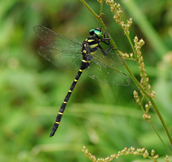
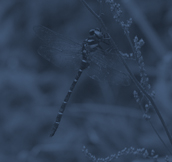 Anotogaster sieboldii (Golden-ringed Dragonfly) Cordulegastridae
Anotogaster sieboldii (Golden-ringed Dragonfly) Cordulegastridae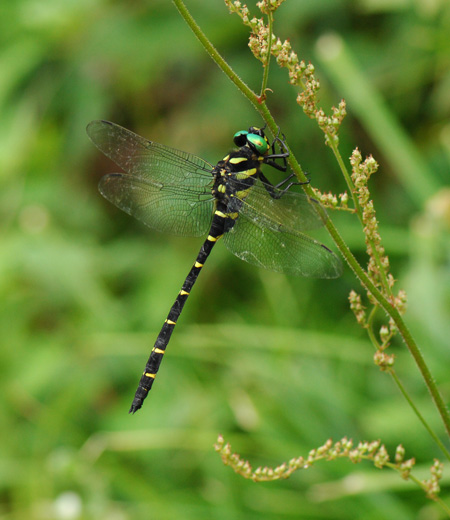 Main region: Hokkaido, Honshu, Shikoku, Kyushu, Okinawa, Sado Island, Tsushima, Yaku Island and Amami Oshima.
Main region: Hokkaido, Honshu, Shikoku, Kyushu, Okinawa, Sado Island, Tsushima, Yaku Island and Amami Oshima.
The largest dragonfly in Japan and its body length become up to about 11 cm.
Found at streams and swamps in flatland to low elevations, and at streams in mountains but seen in city area on rare occasions.
Their body is quite appealing because large eyes are dark green and body is black with yellow regularly placed stripes so it is appealing.
Main foods are small insects and catch them while flying.
Male adults hold territory and patrol within the area.
Female adults hovers dipping abdomen beneath water and lay eggs.
●Length about 90 to 100 mm
●Adult Flight Season June to about October -
Calopteryx cornelia Calopterygidae
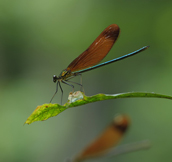
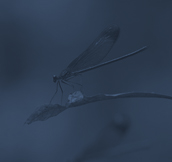 Calopteryx cornelia Calopterygidae
Calopteryx cornelia Calopterygidae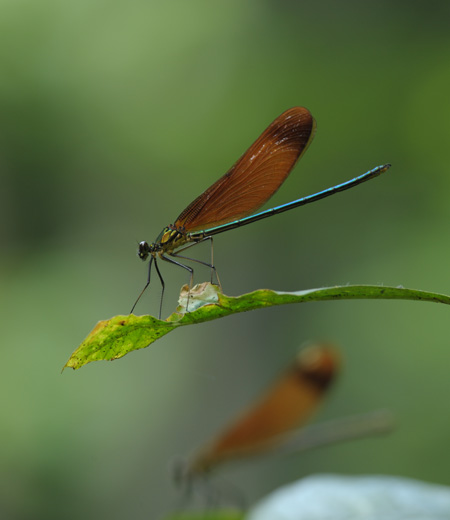 Main region: Hokkaido, Honshu, Shikoku and Kyushu.
Main region: Hokkaido, Honshu, Shikoku and Kyushu.
Found at clear streams and streams from low elevation to mountains.
Is the largest species of calopterygidae in Japan. Main foods are small insects.
Transparent deep brownish wings and metallic green abdomen look elegant when slowing flying at waterside.
Female has white pterostigma at tips of wings and abdomen is brown.
Male adults hold territory and mate with female fly in the territory.
Female lays eggs underwater.
With airy layer trap its body and wings, it can stay underwater nearly one hour.
●Length about 60 to 65 mm
●Adult Flight Season May to about September -
Epiophlebia superstes Epiophlebiidae
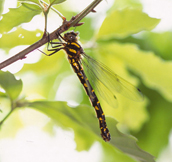
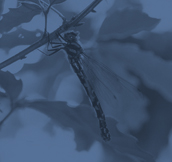 Epiophlebia superstes Epiophlebiidae
Epiophlebia superstes Epiophlebiidae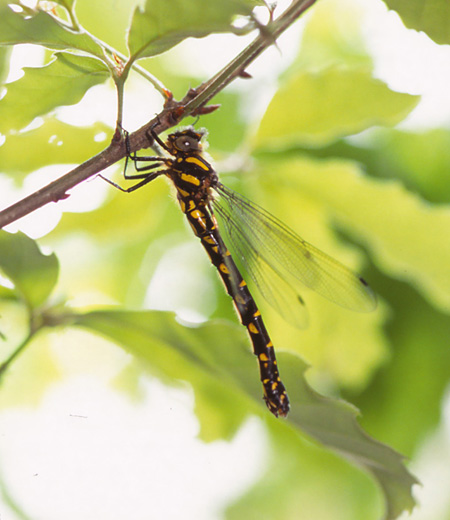 Main region: Hokkaido, Honshu, Shikoku and Kyushu.
Main region: Hokkaido, Honshu, Shikoku and Kyushu.
Globally known as “living fossils” because many parts of their body including reproductive organs.
One other species in epiophlebiidae family remains in Himaraya and North Eastern China.
Body is similar to gomphidae but wings are like damselflies because the shapes of front and back wings are almost the same.
Found at upstream or streams surrounded by woods and main foods are small insects including flies, mosquitos. Female lays eggs on stems of plants at waterside and emerged nymphs live between stones in streams.
Live underwater for seven to eight years, waterside for following one year and then emerge to adults.
●Length about 50 to 60 mm
●Adult Flight Season about May -
Graptopsaltria nigrofuscata Cicadidae
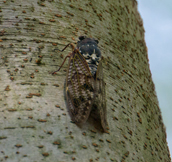
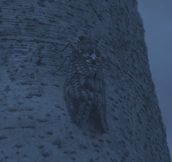 Graptopsaltria nigrofuscata Cicadidae
Graptopsaltria nigrofuscata Cicadidae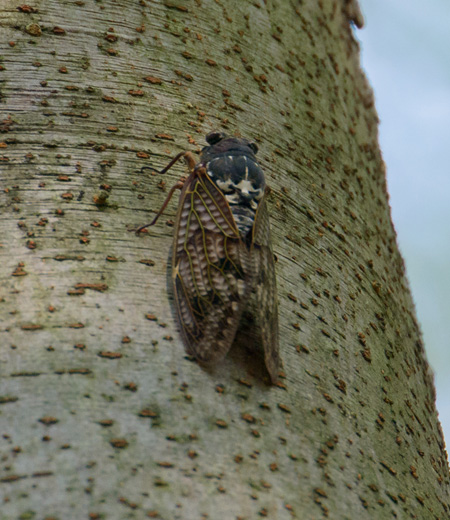 They live widely in Hokkaido, main land Honsyu, Shikoku, Kyusyu as well as Tsushima Island and Yakushima Island.
They live widely in Hokkaido, main land Honsyu, Shikoku, Kyusyu as well as Tsushima Island and Yakushima Island.
Thought they inhabit at copses and forests in plain ground and at the mountain areas, they can take a sip of sap.
They are seen at the park where there are large trees and at the orchard that Japanese pears are grown.
They are one of national wide popular bees to see most occasionally.
Male cicadas only shrill among Cicadoidea and their shrilling sounds like ‘Jyu-ey’ or ‘Jour-Jour-Jour-Jour’.
It is said that their name is taken after this shrilling sound very similar to the frying sound.
Wings are opacity and dark reddish-brown color with patterns of light and shade here and there.
Female lays their eggs into the tree bark.
Eggs incubate about in 1 year.
The larvae live underground on sap sucking from the tree root, and crawl up to the ground in 6 to 7 years to emerge out of pupa into adult insect.
●Length(overall-length from head to wing) about 50 to 60 mm
●Adult Flight Season July to about September -
Meimuna opalifera Cicadidae
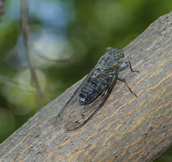
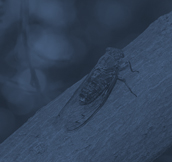 Meimuna opalifera Cicadidae
Meimuna opalifera Cicadidae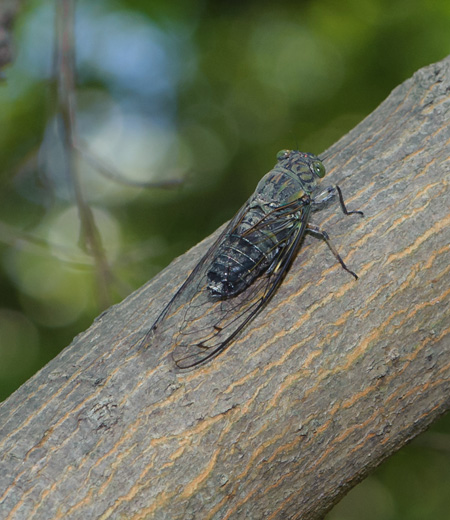 They live widely in Hokkaido, main land Honsyu, Shikoku, Kyusyu as well as Tsushima Island and Yakushima Island.
They live widely in Hokkaido, main land Honsyu, Shikoku, Kyusyu as well as Tsushima Island and Yakushima Island.
Thought they inhabit at trees and copse in plain ground, at the low mountain areas.
We can see them in the public parks in residential districts or on the roadside trees.
They fly over various trees to take a sip of sap of trees.
High season for them to appear so often is August to September.
What’s impressive is their chirp ‘OH-SHE-TSUKU-TSUKU’ with unique inflection in it and they are named after this sound chirp. It does not matter to them when to chirp, in the morning or in the afternoon.
The body color is yellowish-brown and black with green patterns here and there.
As of the similarity and difference between male and female, both of them are almost same body size, male has round shaped abdomen due to air bag meanwhile female has sharp shape of rear due to ovipositor (tubular organ used for laying eggs).
●Length(overall-length from head to wing) about 45 mm
●Adult Flight Season July to about October -
Tanna japonensis Cicadidae
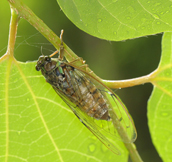
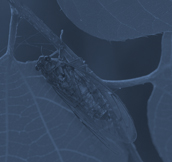 Tanna japonensis Cicadidae
Tanna japonensis Cicadidae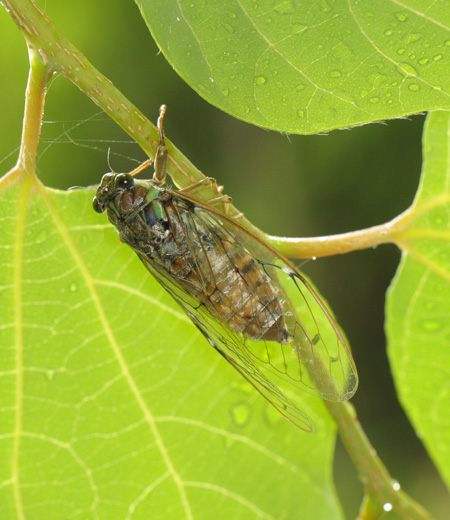 They live in southern part of Hokkaido, main land Honsyu, Shikoku, Kyusyu as well as Yakushima Island.
They live in southern part of Hokkaido, main land Honsyu, Shikoku, Kyusyu as well as Yakushima Island.
They inhabit mainly in copse in plain ground and at the low mountain areas.
They are the kind that show up rather early season like June, and the breeding high season comes at most in July.
They chirp with accordance with their name ‘Hi-Gu-Ra-Shi’ (Evening cicada) at evening twilight time, such as metallic chirping ‘He-He-He-He-He…’.
Their chirp is often expressed as ‘Kana-Kana’ literary. Very early morning at the breaking dawn when it’s still in the darkness or when it comes to cloudy day, they chirp even during daytime.
The body color depends upon each one, but most of them have the dark reddish-brown base color with patterns of green and black here and there.
Most male have large swollen abdomen that is air bag, while female is sharp rear due to ovipositor (tubular organ used for laying eggs).
Sometimes we notice that white cotton like thing adheres to them; this is larva of Epipomponia nawai that parasite original breed.
●Length(overall-length from head to wing) about 40 to 50 mm
●Adult Flight Season June to about September -
Oncotympana maculaticollis Cicadidae
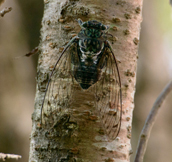
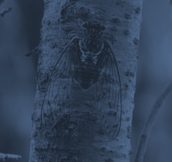 Oncotympana maculaticollis Cicadidae
Oncotympana maculaticollis Cicadidae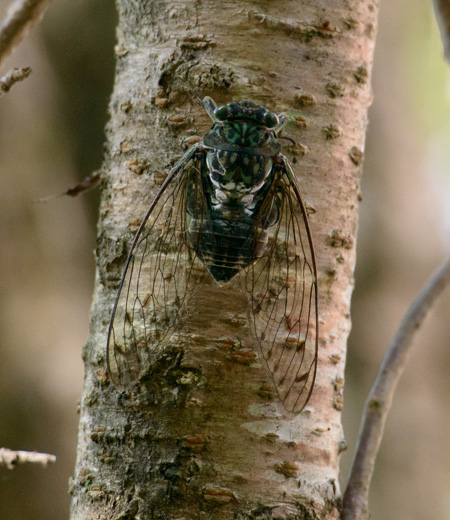 They live in southern part of Hokkaido, main land Honsyu, Shikoku, Kyusyu as well as Tsushima Island.
They live in southern part of Hokkaido, main land Honsyu, Shikoku, Kyusyu as well as Tsushima Island.
They inhabit in copse in plain ground and at mountain areas.
In the Kanto region they are so popular that we can often see them as many times as we do Graptopsaltria nigrofuscata at the city roadside trees or at the trees in the park.
They begin to boom to appear around in middle of July. As their chirp shows it, they sing loud like ‘Min-Min-Min’ (chirp sound of a robust cicada).
Their body has mottles of black color and green color with its center being spouted by white powder.
Rare ones of them include the one with entire body all black, or the one with entire body all green which is called ‘Mikado Type’.
Their wings are transparent and almost twice as long as their body.
Like the other bees, they take a sip of sap by piercing their sharp bait into the trees.
It takes 6 years that incubated larvae become imagines.
●Length(overall-length from head to wing) about 55 to 63 mm
●Adult Flight Season July to about September -
Sastragala esakii Acanthosomatidae
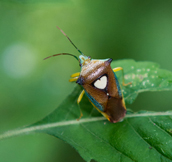
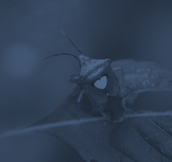 Sastragala esakii Acanthosomatidae
Sastragala esakii Acanthosomatidae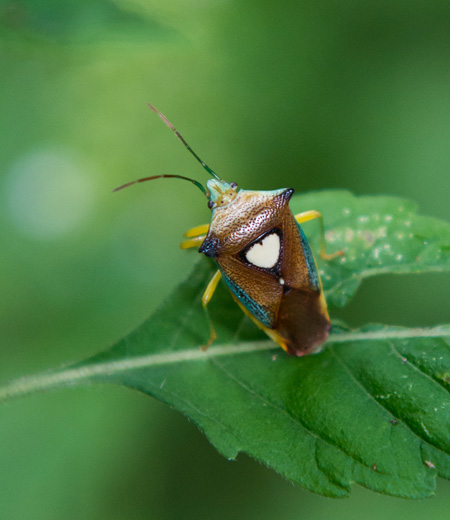 Main Region: Honshu, Shikoku, Kyushu, Tsushima and Amami Island.
Main Region: Honshu, Shikoku, Kyushu, Tsushima and Amami Island.
Found in woods and grasslands from flatlands to mountains.
Color on the back is brown and front part of abdomen from fore wings and legs are green to yellow-green.
Is a family of acanthosomatidae which thorax is angulated.
This species have striking heart-shaped yellow-white pattern.
Named after Japanese entomologist Prof. Teiso Esaki.
Feed on sap of giant dogwood, Toxicodendron succedaneum, oudo and Japanese Prickly-ash and often found on these trees.
Female lay eggs on the back of leaves including giant dogwood and usually guards them by holding and covering them.
Continue to protect hatched nymphs from external enemies.
●Length about 10 to 12 mm
●Adults Flight Season May to about October -
Statilia maculata Mantidae
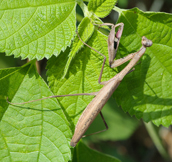
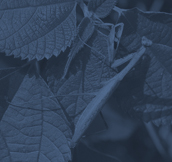 Statilia maculata Mantidae
Statilia maculata Mantidae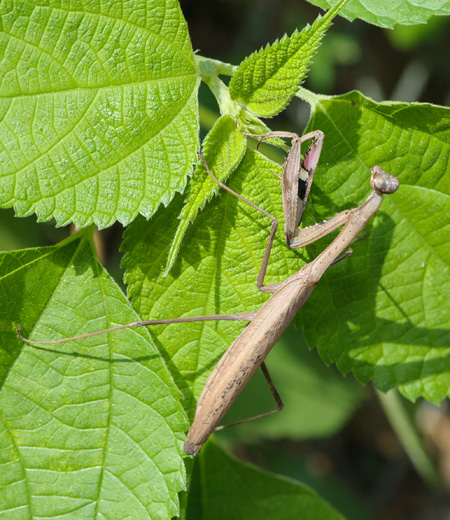 Main Region: Honshu, Shikoku, Kyushu, Izu Islands, Tsushima and Yaku Island. Found in forest and grasslands from flatland to mountains and farmlands. Body color is ocher to dark brown for most of species but green in rare cases. Inner sides of grasping front legs are black which is quite distinctive. When plants are green, found on ground or trees and in autumn found often on dead leaves. Ootheca is elongated and female lays them on rocks or tree trunks close to the ground.
Main Region: Honshu, Shikoku, Kyushu, Izu Islands, Tsushima and Yaku Island. Found in forest and grasslands from flatland to mountains and farmlands. Body color is ocher to dark brown for most of species but green in rare cases. Inner sides of grasping front legs are black which is quite distinctive. When plants are green, found on ground or trees and in autumn found often on dead leaves. Ootheca is elongated and female lays them on rocks or tree trunks close to the ground.
●Length about 36 to 60 mm
●Adults Flight Season August to about November -
Acromantis japonica Acromantidae
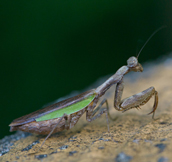
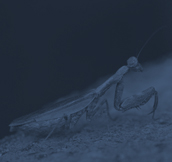 Acromantis japonica Acromantidae
Acromantis japonica Acromantidae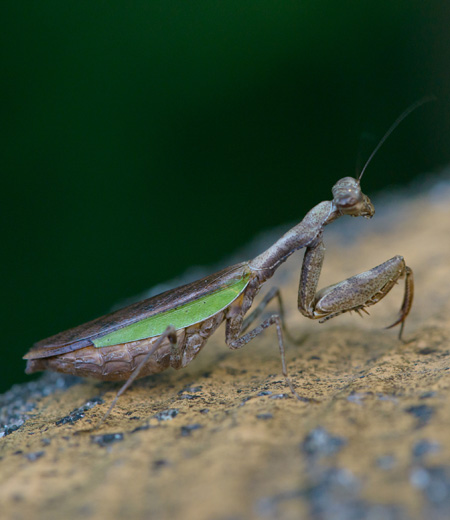 Main Region: Honshu, Shikoku, Kyushu and Nansei Islands. Found in woods and surrounding grasslands from low elevations to mountains. Is a very small mantis. Even the body size is around 3 cm, have big wings covering abdomen that is to identify adults. Body color is green and brown and some have mixed color for example brown on back and green on grasping front legs. When sensing dangers, stop moving and hold the body low, and drop itself to the ground. Sometimes place legs right beside abdomen pretending to be dead. Head is wide triangular-shaped with protruding compound eyes on either side. Nymphs emerged from eggs are black like ants.
Main Region: Honshu, Shikoku, Kyushu and Nansei Islands. Found in woods and surrounding grasslands from low elevations to mountains. Is a very small mantis. Even the body size is around 3 cm, have big wings covering abdomen that is to identify adults. Body color is green and brown and some have mixed color for example brown on back and green on grasping front legs. When sensing dangers, stop moving and hold the body low, and drop itself to the ground. Sometimes place legs right beside abdomen pretending to be dead. Head is wide triangular-shaped with protruding compound eyes on either side. Nymphs emerged from eggs are black like ants.
●Length about 25 to 32 mm
●Adults Flight Season June to about October -
Baculum irregulariterdentatum(Stick Insect) Phasmatidae
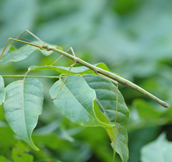
 Baculum irregulariterdentatum(Stick Insect) Phasmatidae
Baculum irregulariterdentatum(Stick Insect) Phasmatidae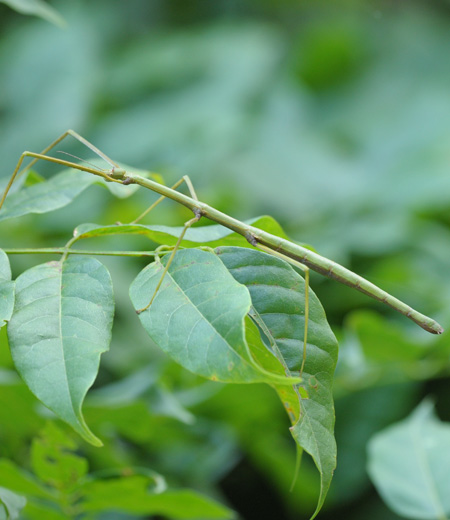 They live in main land Honsyu, Shikoku, Kyusyu.
They live in main land Honsyu, Shikoku, Kyusyu.
They inhabit at bushes and in green tracts of grassy places in low ground to low mountain areas.
Some of them have green body color, others have dark-brown.
As they are known very well, they transform themselves into the shapes such as branch of trees or stalk of leaves, and stay still so well that we cannot tell them.
Even imagines have no wings and don’t fly.
They move slowly from trees to leaves to eat leaves of pants including Flowering cherries and Quercus serrate.
Very similar Phraortes illepidus has antennas as long as their front legs, by which we can tell them from the others.
Furthermore, there live Micadina phluctaenoides having wings at Mt. Takao, which have a very rare reproduction style ‘Parthenogenesis’ that means females can lay eggs without copulation with males.
●Length about 60 to 100 mm
●Adult Flight Season July to about November -
Protohermes grandis(Dobsonfly) Corydalidae
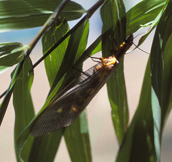
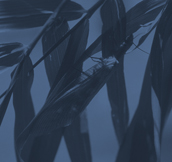 Protohermes grandis(Dobsonfly) Corydalidae
Protohermes grandis(Dobsonfly) Corydalidae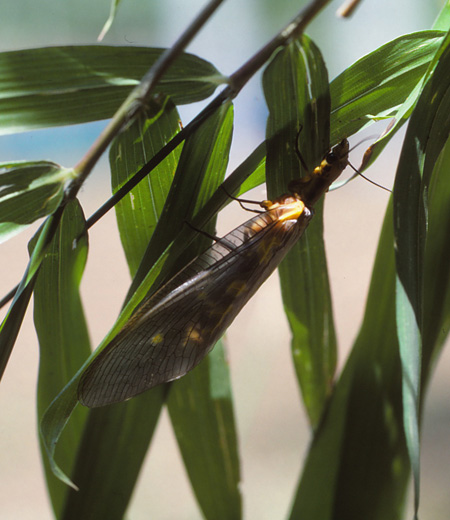 Main Region: Hokkaido, Honshu, Shikoku and Kyushu.
Main Region: Hokkaido, Honshu, Shikoku and Kyushu.
Found in mountain streams and forests from flatlands to mountains.
Have skinny body with large four wings but they are not in family of dragonflies.
The major difference from dragonflies is holometabolism which includes pupa stage where as dragonflies are hemimetabolic. Body color is light yellow-brown with yellow spots on wings.
Rest in forests and grasslands near streams during daytime and become active at night and fly to various trees for sap.
Also are attracted to lights.
Have large mandibles on head and try to bite by moving long thorax parts when randomly caught by human beings. This resembles snakes, hence the Japanese name hebi-tombo literally meaning snake dragonfly.
Larvae are called magotaro-mushi literally meaning grandson bugs and live in clear water and eat aquatic insects.
●Length about 36 to 40 mm
●Adults Flight Season June to about September -
Panorpa japonica Panorpidae
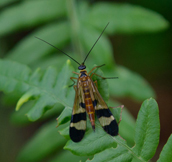
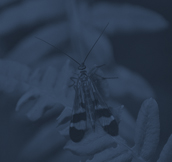 Panorpa japonica Panorpidae
Panorpa japonica Panorpidae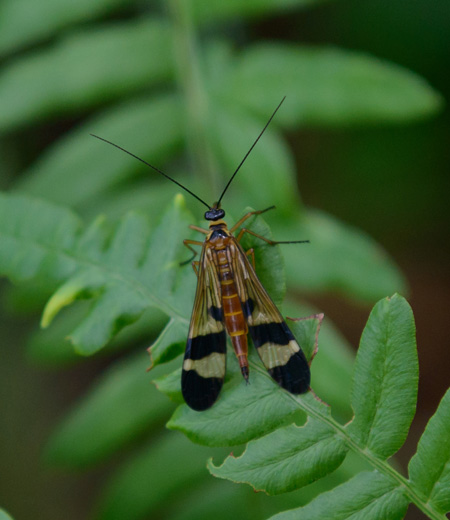 Main Region: Honshu, Shikoku and Kyushu.
Main Region: Honshu, Shikoku and Kyushu.
Found in woods and green space from low elevations to mountains.
From the middle of abdomen to the tip of abdomen is curled like tails of scorpions as panorpidae in Japanese means curled tip of abdomen states.
This is unique to male and the abdomen of female is thick and does not curl at tips.
Tips of abdomen of male are scissors-like shape that is used to hold female when mating and to fight with other males.
Feed on body fluids of dead insects and juice of fruits.
Male feed female dead insects and mate while female is eating that is unique to this species.
Ones emerge in spring are black body color but the ones in summer have yellowish and does look like other species.
Larvae live in soils and become pupa by making cocoons.
●Length about 13 to 20 mm
●Adults Flight Season April to about September -
Veronica miqueliana Scrophulariaceae
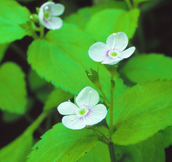
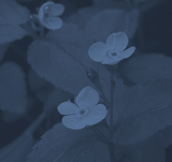 Veronica miqueliana Scrophulariaceae
Veronica miqueliana Scrophulariaceae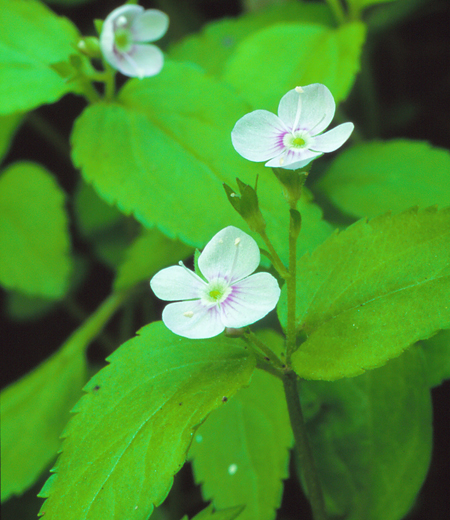 Perennial herbs on swampy forest ground near streams. Bloom in late spring after trees shoot out buds. The fan-shaped calyx after flowering resemble the hoe-shaped helmet crest (Kuwagata), hence the Japanese name Kuwagata-so. Color of flowers is light red-purple and bloom one to five from the base of leaves on upper parts of stems. The size of flower is 1 cm in diameter and has some purple lines radiating from the center of petals. The dish-shaped corolla is parted, making flowers have four petals. Leaves are opposite with two leaves. The shape of leaves is egg-shaped with pointed tip and roughly toothed margins. The ones towards tips of stems are large and about 3 to 5 cm. Stems and leaves have short hairs.
Perennial herbs on swampy forest ground near streams. Bloom in late spring after trees shoot out buds. The fan-shaped calyx after flowering resemble the hoe-shaped helmet crest (Kuwagata), hence the Japanese name Kuwagata-so. Color of flowers is light red-purple and bloom one to five from the base of leaves on upper parts of stems. The size of flower is 1 cm in diameter and has some purple lines radiating from the center of petals. The dish-shaped corolla is parted, making flowers have four petals. Leaves are opposite with two leaves. The shape of leaves is egg-shaped with pointed tip and roughly toothed margins. The ones towards tips of stems are large and about 3 to 5 cm. Stems and leaves have short hairs.
●Season Early May to about Early June
●Height about 10 to 20 cm
●Place Trial 6, Ura-Takao -
Scutellaria brachyspica Labiatae
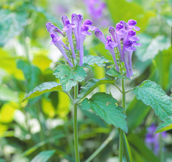
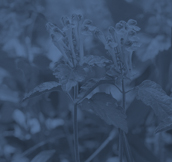 Scutellaria brachyspica Labiatae
Scutellaria brachyspica Labiatae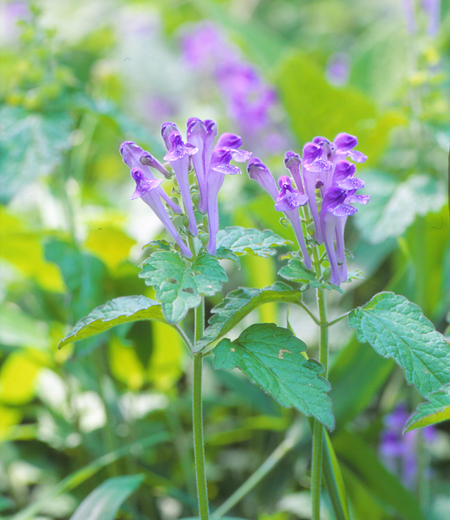 Perennial herbs found at forest edges and on grasslands from the base of mountains to mountain peak. In Mt. Takao, plants in scutellaria genes and scutellaria pekinensis var. transitra have leaves and truss of flowers on one side of stem but this species have leaves covering upper parts of stems. Flowers are curved tubular shape and about 2 cm long. Bloom some upright flowers at the tip of stem. The name of scutellaria, Tatsunami-so come from the flower shape resembling the crest of wave. This species Oka-tatsunamiso literally meaning hills scutellaria was named because scutellaria grows on hills. Flowers are light blue-purple and stems have short hair facing downwards. Leaves are wide egg-shaped with roughly tooted margins and larger on upper parts about 5 cm long. After flowering, calyx become plate-like shape and close. Seeds grew inside of calyx pop when ripen.
Perennial herbs found at forest edges and on grasslands from the base of mountains to mountain peak. In Mt. Takao, plants in scutellaria genes and scutellaria pekinensis var. transitra have leaves and truss of flowers on one side of stem but this species have leaves covering upper parts of stems. Flowers are curved tubular shape and about 2 cm long. Bloom some upright flowers at the tip of stem. The name of scutellaria, Tatsunami-so come from the flower shape resembling the crest of wave. This species Oka-tatsunamiso literally meaning hills scutellaria was named because scutellaria grows on hills. Flowers are light blue-purple and stems have short hair facing downwards. Leaves are wide egg-shaped with roughly tooted margins and larger on upper parts about 5 cm long. After flowering, calyx become plate-like shape and close. Seeds grew inside of calyx pop when ripen.
●Season Mid May to about Mid June
●Height about 20 to 50 cm
●Place Trail 6 -
Lithospermum zollingeri Boraginaceae
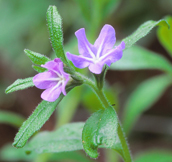
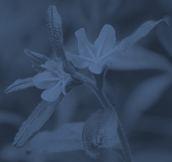 Lithospermum zollingeri Boraginaceae
Lithospermum zollingeri Boraginaceae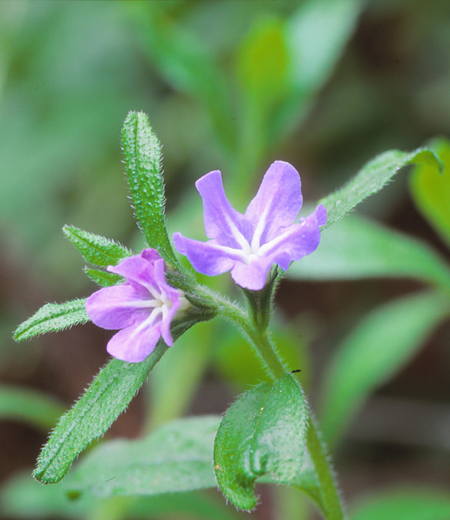 They are a perennial plant that grows at such sunny and arid places as in the pool of the forests in the mountain area and the grasslands (Perennial plant takes several years to grow). As the color of the flower is compared to the firefly luminescence, they are named. During the season of new green leaves, flowers tinged with vivid blue-purple color stand out like floating from others. The flower is about 1.5 to 2 cm in diameter, and few of them bloom in cluster at the root of the leaf at the upper part of a thin stalk. The flower petal is split into 5 with the center part white striped like being arched. The leaf is thin and long shoehorn-shaped about 2 to 6 cm long. The leaves and stems bear hard trichome and rough to touch them. When the flowers wither, they grow long branches ‘stolons’ (Stolon: Sousyutsushi is the branch creeping on the ground to extend, also called ‘Runner’), and furthermore they let the roots out from the top of the stolon branches to cultivate a new stub. The leaves remain still on even in the winter.
They are a perennial plant that grows at such sunny and arid places as in the pool of the forests in the mountain area and the grasslands (Perennial plant takes several years to grow). As the color of the flower is compared to the firefly luminescence, they are named. During the season of new green leaves, flowers tinged with vivid blue-purple color stand out like floating from others. The flower is about 1.5 to 2 cm in diameter, and few of them bloom in cluster at the root of the leaf at the upper part of a thin stalk. The flower petal is split into 5 with the center part white striped like being arched. The leaf is thin and long shoehorn-shaped about 2 to 6 cm long. The leaves and stems bear hard trichome and rough to touch them. When the flowers wither, they grow long branches ‘stolons’ (Stolon: Sousyutsushi is the branch creeping on the ground to extend, also called ‘Runner’), and furthermore they let the roots out from the top of the stolon branches to cultivate a new stub. The leaves remain still on even in the winter.
●Season Mid April to about Mid May
●Height about 15 to 20 cm
●Place Minami-Takao -
Gentiana zollingeri Gentianaceae
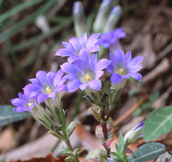
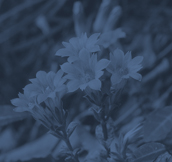 Gentiana zollingeri Gentianaceae
Gentiana zollingeri Gentianaceae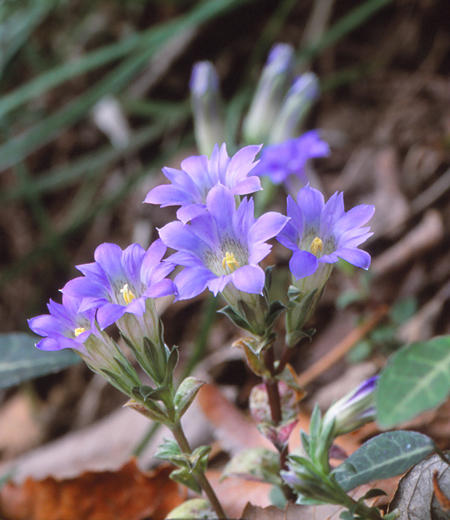 They are biennial plant that grows at copse and grassland meadow in the sunny countryside fields (biennial plant sprouts in autumn, overwinter, and bear flowers in next spring). The bud shape reminds us of the writing brush, which is the reason they are named Gentiana zollingeri. When it’s clear and sunny, they’re open. Meanwhile, when cloudy or rainy, keep close. The flower is a horn shape about 2 to 2.5 cm long and several of them gather to bloom at the top of stalk. The flower is divided into 5 at the top, and there are also accessory paraflocculus between the divided flowers. This makes them seen 10 divided flower petals. The flower is blue-purple, and rarely white. The leaves thickly growing on the stalk are small egg-shaped, a bit thick, 0.5 to 1.2 cm long, and are often tinged with purplish red color.
They are biennial plant that grows at copse and grassland meadow in the sunny countryside fields (biennial plant sprouts in autumn, overwinter, and bear flowers in next spring). The bud shape reminds us of the writing brush, which is the reason they are named Gentiana zollingeri. When it’s clear and sunny, they’re open. Meanwhile, when cloudy or rainy, keep close. The flower is a horn shape about 2 to 2.5 cm long and several of them gather to bloom at the top of stalk. The flower is divided into 5 at the top, and there are also accessory paraflocculus between the divided flowers. This makes them seen 10 divided flower petals. The flower is blue-purple, and rarely white. The leaves thickly growing on the stalk are small egg-shaped, a bit thick, 0.5 to 1.2 cm long, and are often tinged with purplish red color.
●Season Mid April to about Mid May
●Height about 5 to 10 cm
●Place Oku-Takao, Minami-Takao -
Chamaele decumbens Umbelliferae
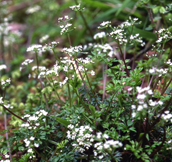
 Chamaele decumbens Umbelliferae
Chamaele decumbens Umbelliferae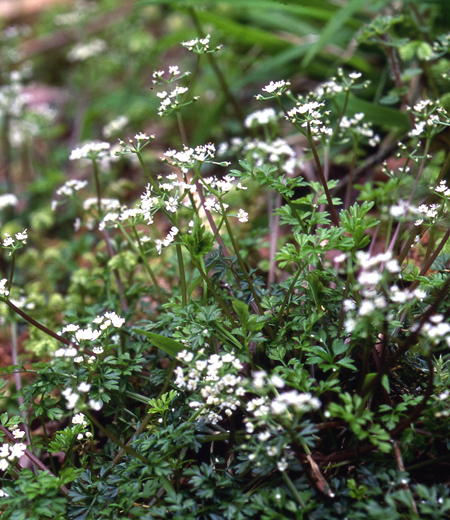 They are a perennial plant that grows at such places as in the pool of the forest and the roadside along the mountain stream. (Perennial plant takes several years to grow). In early spring the flowers blossom before the leaves sprout. Entire plant is soft and has a subtle atmosphere. In Chinese character, their name is expressed as Sentoso, but its name derivation is unexplained. The shape of the leaves looks like the one of Coptis japonica var. dissecta (Labiatae), so they have another name ‘Chamaele decumbens’. The leaves are the compound leaf consisting of 3 as one and each compound leaf has minute split. Their characteristic is the leafstalk (Youhei) is tinged with purple color, grown from the root, and lets the stalk grow between the leaves with lots of white flowers about 1 mm in diameter at the tip.5 flower petals are attached curved inward and a yellow male stamen out of the flower outstands. When the flowers wither, they bear the elliptically-shaped seeds about 3 to 5 mm.
They are a perennial plant that grows at such places as in the pool of the forest and the roadside along the mountain stream. (Perennial plant takes several years to grow). In early spring the flowers blossom before the leaves sprout. Entire plant is soft and has a subtle atmosphere. In Chinese character, their name is expressed as Sentoso, but its name derivation is unexplained. The shape of the leaves looks like the one of Coptis japonica var. dissecta (Labiatae), so they have another name ‘Chamaele decumbens’. The leaves are the compound leaf consisting of 3 as one and each compound leaf has minute split. Their characteristic is the leafstalk (Youhei) is tinged with purple color, grown from the root, and lets the stalk grow between the leaves with lots of white flowers about 1 mm in diameter at the tip.5 flower petals are attached curved inward and a yellow male stamen out of the flower outstands. When the flowers wither, they bear the elliptically-shaped seeds about 3 to 5 mm.
●Season Late March to about Late April
●Height about 10 to 20 cm
●Place Trail 1 to 6, Jyataki, Ura-Takao -
Viola eizanensis Violaceae
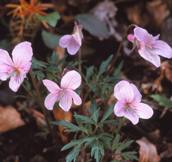
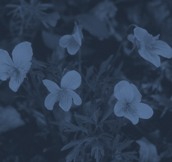 Viola eizanensis Violaceae
Viola eizanensis Violaceae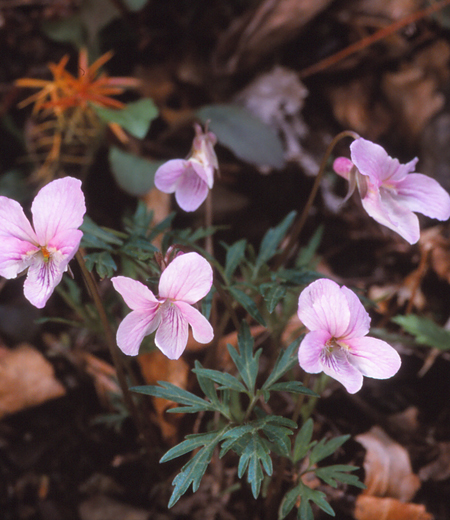 Perennial herbs found in various areas from shady to sunny forest floor, forest edges near streams and forest trails. The Japanese name Eizan-sumire literally meaning Hiei mountain viola was named because it was first found in Mt. Hiei (Shiga prefecture). Have unique leaves, the ones in spring is pinnate in three like a foot of bird with toothed margins but in summer they grow long about 15 to 25 cm. When looking at these large leaves, one may not recognize it as a viola. Petioles and peduncles grow rising from the stem grow underground. Flowers are 2 cm in diameter and its color is from white to light red. Have wavy edged petals and slightly scented. Spur is thick and 7 mm long. The lateral sepals are hairy.
Perennial herbs found in various areas from shady to sunny forest floor, forest edges near streams and forest trails. The Japanese name Eizan-sumire literally meaning Hiei mountain viola was named because it was first found in Mt. Hiei (Shiga prefecture). Have unique leaves, the ones in spring is pinnate in three like a foot of bird with toothed margins but in summer they grow long about 15 to 25 cm. When looking at these large leaves, one may not recognize it as a viola. Petioles and peduncles grow rising from the stem grow underground. Flowers are 2 cm in diameter and its color is from white to light red. Have wavy edged petals and slightly scented. Spur is thick and 7 mm long. The lateral sepals are hairy.
●Season Early April to about Early May
●Height about 5 to 15 cm
●Place Trail 2, Trail 4 to 5, Mt. Inari, Ura-Takao, Oku-Takao, Kita-Takao -
Viola japonica Violaceae
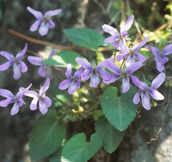
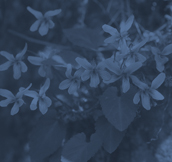 Viola japonica Violaceae
Viola japonica Violaceae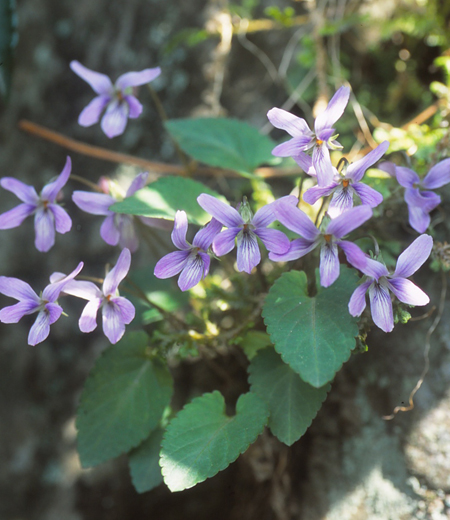 Perennial herbs found on sunny forest floor in low elevations, roadside, riverbank and near residential areas. One of violas starts to bloom in early spring. In Mt. Takao, found in sunny south-facing slopes. The Japanese name Ko-sumire literally meaning small viola but this plant is not small and flowers are 2 cm in diameter. Have purple lines radiating from the center of petals and petals are mainly purple but some are white. Leaves are 2 to 5 cm, elongated triangular to oval-shaped with pointed tip. The back of leaves is purplish. Have many leaves and grow rising from the ground. Similar to viola phalacrocarpa but this plant does not have hair.
Perennial herbs found on sunny forest floor in low elevations, roadside, riverbank and near residential areas. One of violas starts to bloom in early spring. In Mt. Takao, found in sunny south-facing slopes. The Japanese name Ko-sumire literally meaning small viola but this plant is not small and flowers are 2 cm in diameter. Have purple lines radiating from the center of petals and petals are mainly purple but some are white. Leaves are 2 to 5 cm, elongated triangular to oval-shaped with pointed tip. The back of leaves is purplish. Have many leaves and grow rising from the ground. Similar to viola phalacrocarpa but this plant does not have hair.
●Season Late March to about Mid April
●Height about 5 to 10 cm
●Place Trail 6, Ura-Takao -
Viola maximowicziana Violaceae
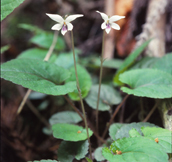
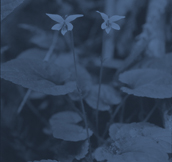 Viola maximowicziana Violaceae
Viola maximowicziana Violaceae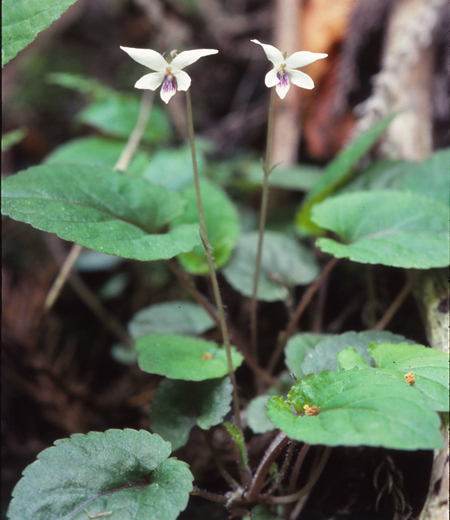 Perennial herbs found in dark and wet areas along streams. In Mt. Takao, start to bloom at the end of viola season. Large leaves are appealing but have small flowers about 1 cm in diameter. Color is white with purple lines radiates from the lower petal. Calyx at the back of petals is hairy with curled tips which is unique to this plant. Shape of leaves is round after sprout but changes to oval or egg-shaped with age. Leaves are 2 to 3..5 cm long, soft texture and not shiny with toothed margins. The back of leaves is purplish. At the end of blooming season, have many self-pollinate cleistogamous flower which does not open.
Perennial herbs found in dark and wet areas along streams. In Mt. Takao, start to bloom at the end of viola season. Large leaves are appealing but have small flowers about 1 cm in diameter. Color is white with purple lines radiates from the lower petal. Calyx at the back of petals is hairy with curled tips which is unique to this plant. Shape of leaves is round after sprout but changes to oval or egg-shaped with age. Leaves are 2 to 3..5 cm long, soft texture and not shiny with toothed margins. The back of leaves is purplish. At the end of blooming season, have many self-pollinate cleistogamous flower which does not open.
●Season Late April to about Mid May
●Height about 5 to 8 cm
●Place Trail 4, Trail 6, Ura-Takao -
Viola mandshurica(Violet) Violaceae
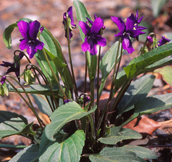
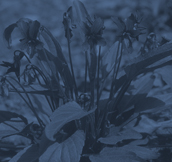 Viola mandshurica(Violet) Violaceae
Viola mandshurica(Violet) Violaceae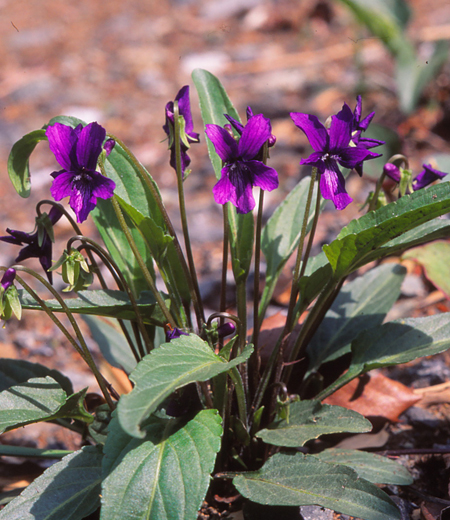 Perennial herbs found in sunny grasslands and on roadside. The numbers of this plant in Mt. Takao is decreasing but found in residential area. The Japanese name Sumire literally meaning viola was named because the shape of flowers from the sides resembles the tool of carpenters called sumi-ire meaning carpenter’s ink pod. Leaves and flowers are in cluster growing upright from the thick underground stem. Leaves are like the shape of elongated shoehorns, rounded tips, 3 to 8 cm long, thick and have wings at petioles that is unique to this plant. Flowers are 1..2 to 1.7 cm in diameter and dark purple. The lateral sepals have white hair and spur is long and about 7 mm.
Perennial herbs found in sunny grasslands and on roadside. The numbers of this plant in Mt. Takao is decreasing but found in residential area. The Japanese name Sumire literally meaning viola was named because the shape of flowers from the sides resembles the tool of carpenters called sumi-ire meaning carpenter’s ink pod. Leaves and flowers are in cluster growing upright from the thick underground stem. Leaves are like the shape of elongated shoehorns, rounded tips, 3 to 8 cm long, thick and have wings at petioles that is unique to this plant. Flowers are 1..2 to 1.7 cm in diameter and dark purple. The lateral sepals have white hair and spur is long and about 7 mm.
●Season Mid April to about Early May
●Height about 7 to 15 cm
●Place Trail 1, Trail 5, Mt. Inari, Ura-Takao, Oku-Takao -
Viola yezoensis f. discolor. Violaceae
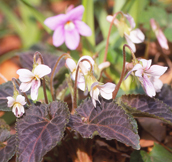
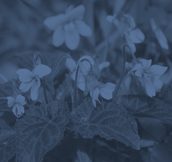 Viola yezoensis f. discolor. Violaceae
Viola yezoensis f. discolor. Violaceae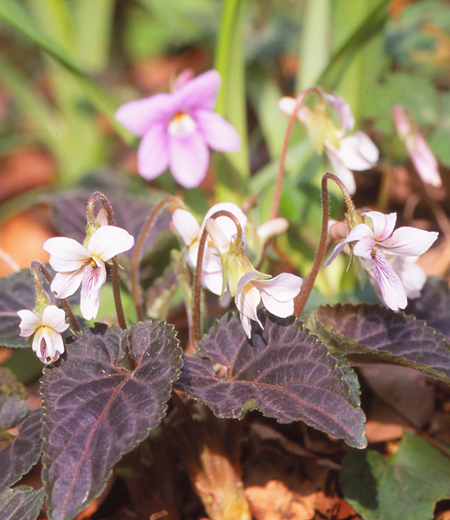 This plant represents Mt. Takao, often called as “the mountain of viola.” Found at wet and half shady forest edges along streams. The Japanese name Takao-sumire literally meaning Mt. Takao viola was named because it was first found in Mt. Takao. It inhabit throughout Japan but many of them found in Mt. Takao. It was first introduced as a varietas of viola yezoensis in 1928 (Showa Era 3). The front side of leaves is dark brown during blooming season that is unique to this plant. After flowering, green leaves grow which makes it difficult to identify them from viola yezoensis. Flowers are 1..5 to 2 cm in diameter and slightly scented. Color of flowers is white with purple fine lines radiating from the center of petals. Leaves are 3 to 6 cm and egg-shaped or elongated egg-shape.
This plant represents Mt. Takao, often called as “the mountain of viola.” Found at wet and half shady forest edges along streams. The Japanese name Takao-sumire literally meaning Mt. Takao viola was named because it was first found in Mt. Takao. It inhabit throughout Japan but many of them found in Mt. Takao. It was first introduced as a varietas of viola yezoensis in 1928 (Showa Era 3). The front side of leaves is dark brown during blooming season that is unique to this plant. After flowering, green leaves grow which makes it difficult to identify them from viola yezoensis. Flowers are 1..5 to 2 cm in diameter and slightly scented. Color of flowers is white with purple fine lines radiating from the center of petals. Leaves are 3 to 6 cm and egg-shaped or elongated egg-shape.
●Season Early April to about Early May
●Height about 5 to 12 cm
●Place Trail 1, Jyataki, Ura-Takao
